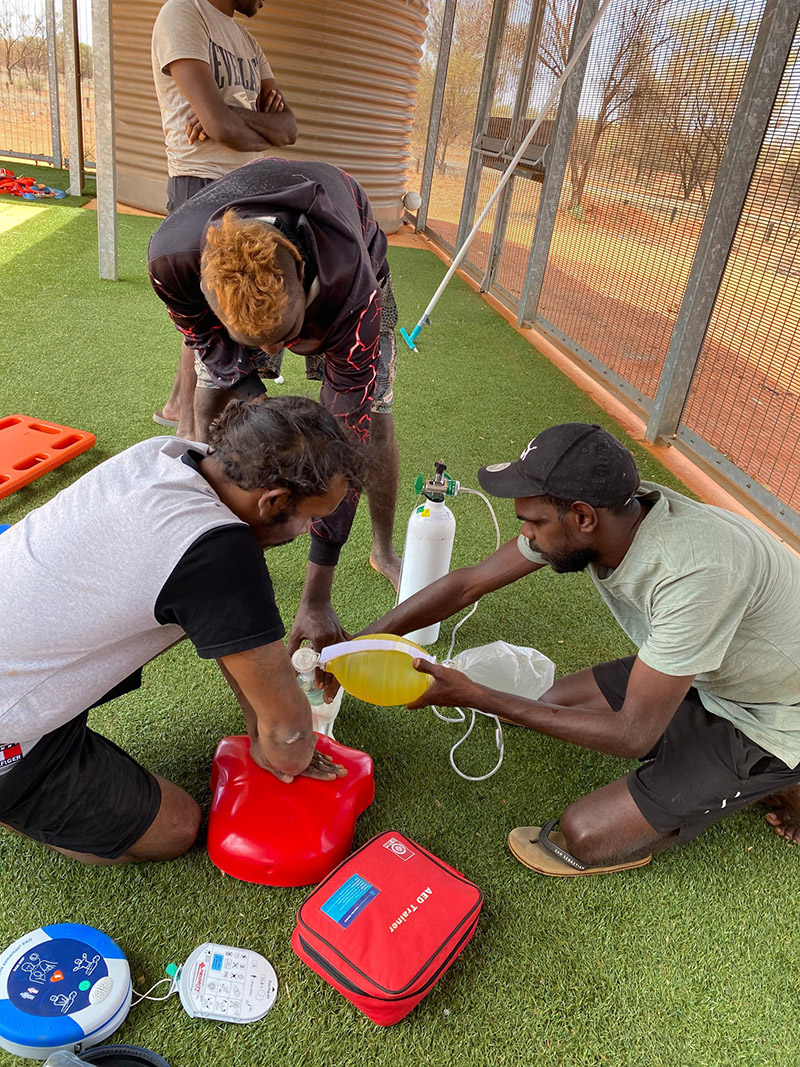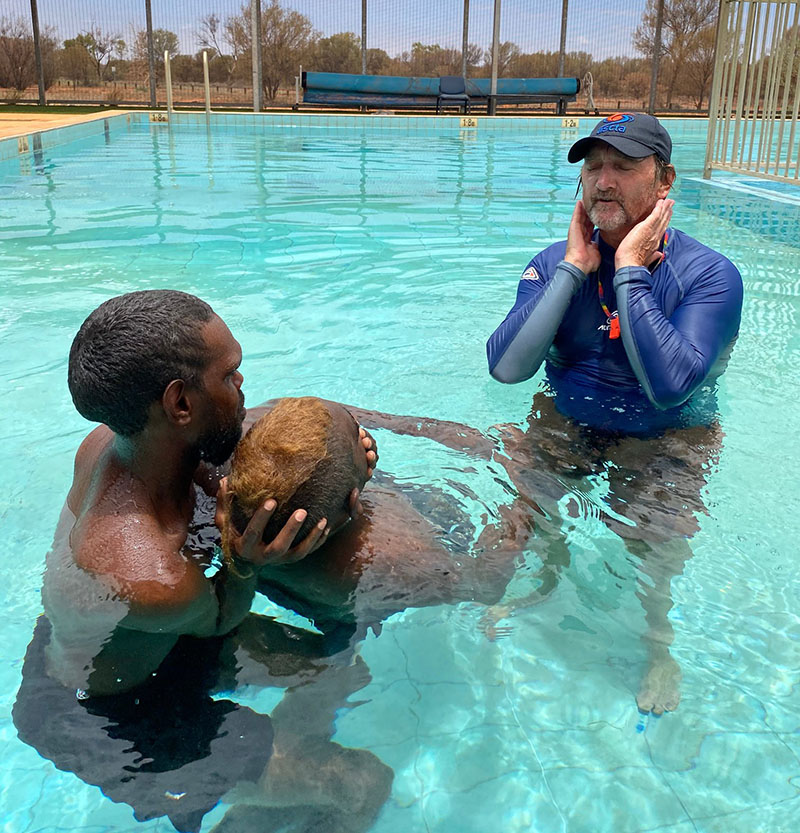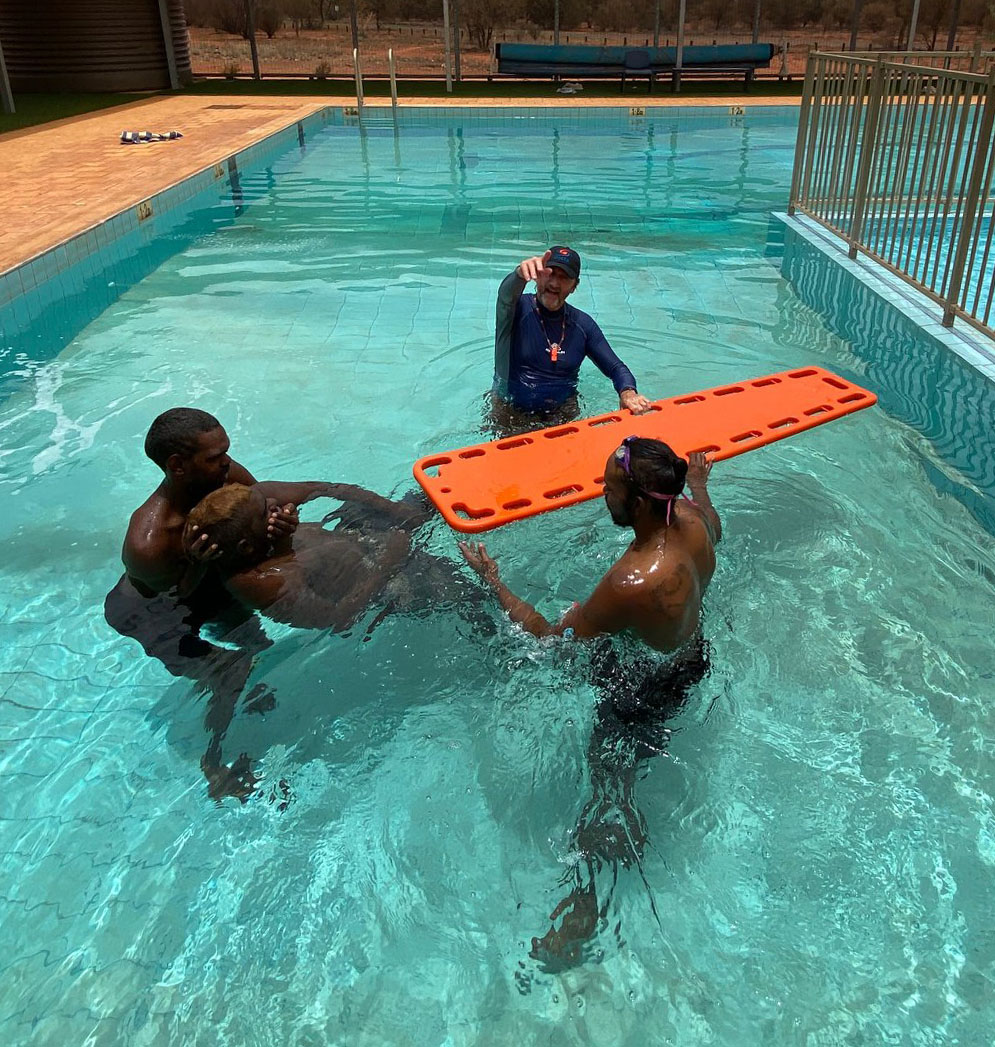Tag: Community Development
On Saturday, July 6, the WETT advisory committee won the education category, recognising nearly two decades of support across a range of partnerships and programs that align with Warlpiri education priorities in Yuendumu, Willowra, Nyirrpi, and Lajamanu.
The committee advises WETT on investing gold mining royalties in community-driven initiatives supporting education and training priorities in the four communities.
Maisie Kitson, a retired teacher of 40 years, has been on the WETT advisory committee for 19 years and is one of the strong Warlpiri women who founded the trust in 2005.
Ms Kitson accepted the award on behalf of her colleagues.
“And when we heard ‘Warlpiri Education and Training Trust,’ we all hugged. I was feeling happy and proud. And my tears were coming down,” she said.
Sharon Anderson, an educator from Lajamanu and member of the WETT advisory committee since 2007, accepted the award with Ms Kitson.
“It’s for WETT. It’s been a great achievement all those years of what we have been doing—all the work with the Kurra Directors, community members, and [project] partners. Everyone is getting involved in children’s education. It’s for all Warlpiri,” Ms Anderson said.
“I thought of the Elders, educators and founding [WETT] members who have been guiding us along our journey. And the four Warlpiri communities.”
Many of WETT’s founding members are still on the advisory committee today, and innovative measures are being taken to support new and younger members in joining the committee and growing into these important roles.
WETT is a Warlpiri-controlled and governed initiative administered through the CLC.
The WETT advisory committee, comprising four Warlpiri representatives from the four communities and one each from Newmont and the CLC, plays a crucial role in designing, planning, and monitoring WETT-funded initiatives. This committee meets three times a year and advises the directors of the Kurra Aboriginal Corporation, whose members are traditional owners of the mine site. The Kurra directors, guided by this advice, allocate funding to the WETT programs.
So far, WETT has invested more than $57 million to support Yapa (Warlpiri people) across its five education program areas:
- Children and families
- Language and culture in schools
- Youth development
- Secondary school support
- Learning community centres
Contact: Tess O’Loughlin | 0461 396 054 | media@admin
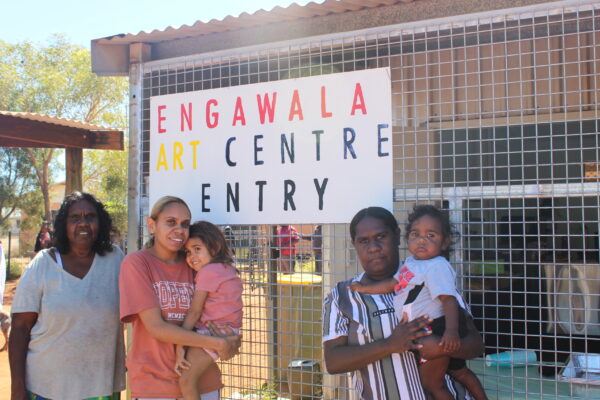
The old store in Engawala has been given a new lease of life, opening as an arts centre.
With few jobs in the community, Engawala’s many talented artists now have a dedicated space to work and earn an income from arts and crafts sales.
Tourists often drop in on Engawala, 200 kilometres northeast of Alice Springs, because the community is next to the Alcoota fossil fields. Those visitors now have a proper place to view and buy the artists’ work.
“The community are really supportive of the arts centre. Especially the board as well and Joy Turner, the elder for this community,” arts centre manager and Engawala local Janine Tilmouth said.
“We did this project so that there was a chance for people to have work and also to have their own community-owned arts centre, instead of someone else coming in and running it,” she said.
They first talked about turning the old store into an arts centre four years ago.
The community allocated a total of $145,000 to the renovation, which was made up of community lease money and matched funds from the National Indigenous Australians Agency.
Four residents then met with the Central Land Council’s community development team and Tangentyere Constructions to work out the details.
“The workers gave the old store a good clean-out and got electricity, benches and drawers,” resident artist Sharon Tilmouth said.
They boarded up some doors and fixed broken windows to make the building safe.
“We had to wait a while to get the work done, but Tangentyere Constructions did a good job,” Janine Tilmouth said.
“They listened to the community and suggested what would be good, with the sink and putting the drawers in.”
Tangentyere Constructions hired local residents Stewart Schaber and Leanne Dodd for some of the work and finished the job within six weeks.
“I helped pull out the fridges and I was painting the wall and glazing the floor. It’s the first time I’ve done this kind of work,” Ms Dodd said.
“I liked getting to work on time and communicating with the other workers.”
She also helped Tangentyere’s Aboriginal tradies Corey Coull and Adrian Shaw to coat the floor and install the benches and trolleys.
Ms Dodds is a local artist and helped the other artists with the designs painted on the floor.
The locals took over the centre ahead of the official launch in August.
“The arts centre looks good inside now. We’ve already started to work in the arts centre, doing paintings. I’m working at the shop now.”
Volunteers from Community First Development, a national organisation which connects skilled volunteers with Aboriginal communities, Taffy Denmark and Marella Pettinato were a big part of the project.
They helped write a business plan and sourced a $100,000 grant from the Aboriginals Benefit Account to paint the old store and build a shade structure. Now the artists can paint outside in good weather.
The money also paid for an eco-toilet, art equipment, insurances, governance training and project management.
During a year-long construction delay staff took part in intensive administration training.
“I got a lot of training from the volunteer Marella, for admin and bookkeeping and getting work-ready for the auditor. It’s a lot of work and I’ve learnt a lot,” said Janine Tilmouth.
Artists are also getting training from art professionals, and 12 community members have enrolled with the Batchelor College to complete visual arts certificates.
“The ladies have been screen printing,” Sharon Tilmouth said. “There was a workshop and one lady taught us. Lots of ladies have been using the arts centre and they’re happy with it.”
A $400,000 grant from the Indigenous Visual Arts Industry Support program pays for a website, the wages of two local art workers for two years and covers the costs of attending interstate art fairs.
Janine Tilmouth said the centre will build on sales through the art fairs and allow them to explore other markets.
“Maybe we can take our artworks to the cities, spread the word and add more to the website,” she said.
The Engawala art centre shows what can be achieved when Aboriginal people work with a lot of different people and organisations to drive their own development.
The money for this project came from the income the community receives from leases of its land and a three-year trial by the CLC and the NIAA.
The matched funds trial funds groups that use new income from land use agreements for community driven projects, but may not have enough money for the projects they want.
If you would like more information about this work please visit https://www.clc.org.au/strengthening-our-communities/
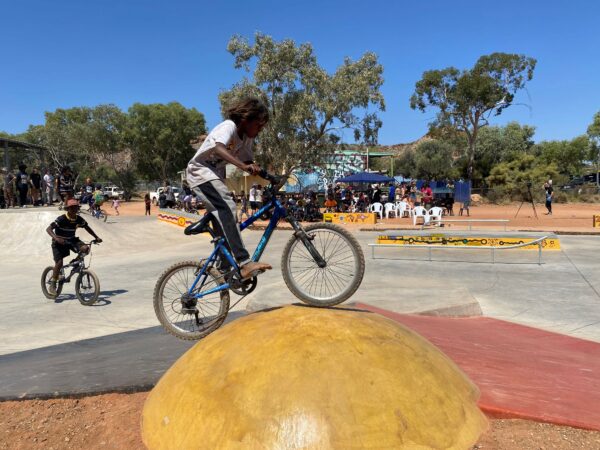
Ltyentye Apurte (Santa Teresa) has become the first remote Aboriginal community in the Northern Territory to fund its very own outdoor concrete skate park.
Nicky Hayes, Eastern Arrernte man and Spinifex Skateboards founder, has been the driving force behind this project.
A keen skateboarder since the age of 11, he became one of the few Aboriginal skateboarders to compete professionally and the NT’s first Aboriginal qualified skateboard instructor.
His next goal was to bring the benefits of skate boarding to his community, 80 kilometres south east of Alice Springs.
Ltyentye Apurte started out with a single skate ramp in 2017 and upgraded to a wooden double storey skate course in the recreation hall.
It launched the outdoor skate park last September.
“This is my way of giving back to community,” Mr Hayes said.
“Having an indoor park, and then from the indoor park to this outdoor park here right now.”
“An outdoor skate park brings a bit more to the community, but also more to young people and families as well. “
For the past four years he has run weekly skateboarding workshops at the recreation hall and the basketball court with the Atyenhenge Atherre Aboriginal Corporation and the youth program of the MacDonnell Regional Council.
“I wanted the skate park to improve the wellbeing of the kids in Ltyentye Apurte,” Mr Hayes said.
“To ensure they stay active and to have an outdoor skate park where families can hang out and accommodate young people’s needs of having fun within a safe space for skateboards, bikes and scooters.”
The skate park near the store, footy oval and basketball court has become another place where residents socialise and enjoy sport.
Mr Hayes took his idea for the $436,600 outdoor skate park to a community meeting two years ago.
A local working group that plans projects with the Central Land Council agreed to fund some of the project cost from Ltyentye Apurte’s community lease income and income from a pilot project of the CLC and the National Indigenous Australian Agency, on the condition that grant funding make up the balance.
“The working group were happy to be part of something that is unique, to be the first community to have an outdoor skate park,” Mr Hayes said.
The community’s Atyenhenge Atherre Aboriginal Corporation and the CLC’s community development team helped the working group to get the project done.
The CLC sourced the grant from the Aboriginals Benefit Account that made the park possible.
Construction started last August, with designers Eastbywest and builders from Grind Projects working every day to complete the park in five weeks.
The local kids made the park their own by painting parts of it with their designs. A painted Aboriginal flag also features prominently.
The community has plans to put in a shelter and landscaping to soften the area and add shade.
Some of the best skateboarders in the country came for the opening of the park to celebrate this Australian skateboarding history event.
Mr Hayes hopes they will keep coming back.
“Bringing competitions here might be a great thing as well, down the track,” he said.
For now he is just happy that the local kids visit the park every day until dark, spending less time on their screens.
“It has been tremendous to see all the kids in the community having fun and enjoying themselves each day.”
Ltyentye Apurte (Santa Teresa) is driving its own development with the opening of a new, community-funded skate park next to its footy oval on Saturday, 16 September.
The event celebrates the vision of Spinifex Skateboards founder Nicky Hayes, who took his idea for the $436,600 park to a community meeting in 2021.
Mr Hayes is a member of the Central Land Council-supported working group that invests Ltyentye Apurte’s leasing income in projects that benefit the whole community.
For the past four years he has run weekly skateboarding workshops at the recreation hall and the basketball court with the Atyenhenge Atherre Aboriginal Corporation and the youth program of the MacDonnell Regional Council.
The workshops helped spread the word about the mental and physical benefits of skating.
“I wanted the skate park to improve the wellbeing of the kids in Ltyentye Apurte,” Mr Hayes said.
“To ensure they stay active and to have an outdoor skate park where families can hang out and accommodate young people’s needs of having fun within a safe space for skateboards, bikes and scooters.”
The remote community, one hour’s drive south of Alice Springs, decided to fund half of the projected project costs on the condition that the balance would be sourced from grant funding. A grant from the Aboriginals Benefit Account and in-kind support from the Atyenhenge Atherre Aboriginal Corporation and the park’s designers and builders, East by West and Grind Projects, allowed the project to be completed in August.
CLC chair Matthew Palmer congratulated community leaders for putting young people first.
“My nieces, nephews and grannies are lucky to grow up in a community that is doing good things with its lease money, keeping them happy, busy and out of trouble.”
“I am very proud of my cousin Nicky, and wish him and the community all the best with the skate park,” he said.
“I hope the next time I visit I can watch a skating competition.”
The opening event will kick off at 11am with a smoking ceremony and dance performance, followed by local bands, a community BBQ with roo tails and, of course, skating.
Contact: Sophia Willcocks | 0488 984 885| media@clc.org.au
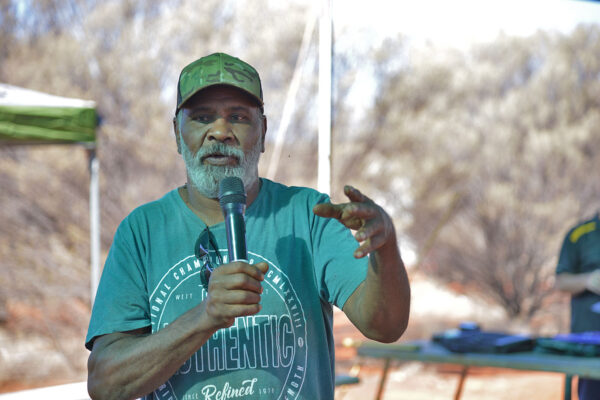
The Central Land Council has pledged to work closely with the new Australian Government to progress overdue policy reforms.
“I congratulate Prime Minister Anthony Albanese and incoming Aboriginal Affairs Minister Linda Burney, and look forward to help fast-track decent housing and jobs in our remote communities,” CLC chair Robert Hoosan said.
“Aboriginal peak organisations have developed a strong model for the creation of real jobs with which we want the new government to replace the Coalition government’s failed work-for-the-dole scheme.”
“We would also like to talk with Mr Albanese and Ms Burney about working with us to keep our young people out of trouble,” he said.
Mr Hoosan is an elder and youth worker who teaches bush skills to young men at risk.
As one of the delegates who endorsed the Uluru Statement for the Heart in 2017, he welcomed Ms Burney’s plan to consult with those who delivered the statement to the nation.
“Let’s all work together to finally get the Uluru Statement implemented in full,” Mr Hoosan said.
“We have been ready for a long time, and now the country is ready too.”
He was heartened to hear the Prime Minister make this promise at the start of his victory speech on Saturday night.
“I trust it means something that this was the first thing Mr Albanese said to the country. “It gives me real hope that, unlike Bob Hawke’s treaty promise, this promise will be kept,” he said.
The Central Land Council welcomes a report about empowering traditional owners in the management and operation of Commonwealth national parks by a senior advisory group on joint management arrangements.
CLC chair Sammy Wilson called on all political parties to commit to the implementation of the SAG’s recommendations.
He also commended Environment Minister Sussan Ley for announcing new investments across three parks, including the Uluru-Kata Tjuta National Park.
“It’s good that the minister has promised to fund more Anangu jobs and to help us fight threats to our land,” Mr Wilson said.
“We want to protect our threatened sites, plants and animals, burn our country the right way and share its stories.”
The tourism operator and former chair of the Uluru-Kata Tjuta National Park’s board of management wants to see the 24 recommendations of the report followed up with real action.
“We’ve been asking for these reforms for a very long time and have taken part in too many reports already, for example the Joint Management Futures report of 2015.”
“There is an election coming and Anangu want to know what the parties will do to help us become equal partners on our land at last,” he said.
CLC chief executive Lesley Turner is hoping for a clear commitment to creating many more meaningful jobs for Anangu on the park, including casual employment.
“The recommended new cultural co-ordinator and engagement officer positions would be a good first step towards putting the intergenerational transfer of Anangu knowledge front and centre,” he said.
“Supporting these workers means accommodating cultural and kinship obligations and requires greater flexibility than the federal public service has been able to muster to date.”
Mr Turner welcomed the SAG’s focus on better resourcing for culturally sustainable tourism by and with Anangu.
“For too long this massive task has been pursued in a token manner,” he said.
“Supporting traditional owners to work in tourism and realise their business ideas takes dedicated and stable resources, such as staffing and access to real business development expertise and mentoring.
“There is a gulf to bridge, from education and training to work readiness, and we look forward to sharing what we’ve learned from our successful ranger and community development programs,” he said.
11 March 2022
Alekarenge students are getting job-ready without having to leave their community, thanks to an innovative horticulture work experience trial.
The Alekarenge work experience pilot program is a partnership between Alekarenge Horticulture Pty Ltd and Centrefarm.
It helps middle and senior school students in the community south of Tennant Creek to gain valuable industry experience.
The students learn to grow crops such as garlic, pumpkins, cabbages, zucchini and watermelons alongside adult workers on the Aboriginal-owned farm near the community and also study horticulture at school.
Economic stimulus funding from the Aboriginals Benefit Account, administered by the Central Land Council, has allowed the project to expand its farm.
The project is using the $1,619,000 grant to buy equipment, build infrastructure and pay wages.
It has seen the first 10 trainees from the community graduate with a Certificate 1 in Agrifood Operations last year.
It has also sold fresh produce to Aboriginal-owned supermarkets in Tennant Creek, Alice Springs and Alekarenge’s Mirnirri Store.
The students also sold the store zucchini chocolate muffins and zucchini fritters they made.
“The funding will go a long way towards providing training and employment opportunities,” Centrefarm’s Joe Clarke said.
The work experience trial aims to offer fulltime work for six to 10 students, or a higher number of parttime placements, before it concludes in 2024.
The CLC’s economic stimulus funding has assisted 14 Aboriginal businesses and organisations with a combined total of more than $17 million in approved grants in 2021.
The money is helping to set up new ranger groups out bush, fund an Aboriginal economic development forum in Alice Springs, support another horticulture business near Ti Tree and kick-start or expand several social enterprises.
One of them has created some competition for Central Australia’s only funeral service.
Desert Funerals, a joint venture between Ngurratjuta and Centrecorp, aims to bring down the high costs of farewelling loved ones.
“Desert Funerals brings new competition to the market whilst committing to culturally appropriate and affordable funerals,” Centrecorp chief executive, Randle Walker, said.
The plan for a not-for-profit, culturally sensitive funeral service for remote communities and town was hatched in late 2018 and the service moved into an office near the Alice Springs cemetery last October.
Almost $400,000 in economic stimulus funding has helped the social enterprise get started, with the business holding its first funeral service in February.
Mr Walker said the funds were “instrumental in assisting Desert Funerals to become a credible alternative funeral provider through funding for hearses, building alterations and funeral equipment”.
Tennant Creek is not missing out on stimulus funding either.
When the Julalikari Council’s Jajjikari Café re-opened at the Nyinkka Nyunyu Art and Culture Centre in early 2020, after it had been closed for five years, the CLC’s stimulus funding allowed it to branch out into street food.
The Jajjikari Café smoko truck is literally a vehicle to train two Aboriginal workers in hospitality and customer service.
“The smoko truck drives around to businesses and the community living areas, serving home made fresh treats,” Julalikari’s Jacqulin Pereira said.
The $190,000 grant also paid for equipment for outdoor film nights and music events, a stage and a jumping castle for the school holidays.
The project goes some way towards meeting the demand for Aboriginal tourism experiences and quality catering services in the town.
The CLC’s economic stimulus project was made possible by an injection of $36.7 million from the Aboriginals Benefit Account in November 2020. For more information email aba.stimulus@clc.org.au, call (08) 8951 0667 or, or go to https://www.clc.org.au/aba-economic-stimulus-package/
The Australian Parliament has taken a big first step towards greater Aboriginal control over the 1.3 billion dollar Aboriginals Benefit Account, following a decades-long campaign by Aboriginal Territorians and their elected representatives.
The passing of the Aboriginal Land Rights (Northern Territory) Amendment (Economic Empowerment) Bill 2021 means that, for the first time, an Aboriginal-controlled body will make decisions about the ABA, which distributes the equivalents of royalties generated by mining on Aboriginal land in the NT.
“The ABA funds were always intended to benefit our people and it’s high time that they get to decide how they want to drive their own development with this income,” Central Land Council chief executive Lesley Turner said.
Since the inception of the land rights act in 1976, federal Aboriginal affairs ministers have been free to take or leave the advice of an ABA advisory committee made up of elected members from the four NT land councils.
Many of them did just that, with former ministers Mal Brough and Nigel Scullion two notable examples.
“I commend the current Minister for Indigenous Australians, Ken Wyatt, for breaking with this tradition and for also supporting the removal of Howard era amendments of the land rights act that were designed undermine the land councils,” Mr Turner said.
“We strongly opposed the devolution of land council functions following the NT Emergency Response, and while the provision has proven ineffective we’re glad to see the back of it.”
A new NT-based commonwealth corporate entity, the NT Aboriginal Investment Corporation, will make decisions about ABA grants and investments when it has been established.
Between now and next June, the corporation’s interim board will meet, hire an acting chief executive, form an investment committee and set up the corporation.
It will have a 12-member board comprising two elected representatives from each of the NT’s land councils, two independent directors appointed by the board and two independent directors appointed by the Australian Government.
It will receive $500 million, roughly half of the current balance of the ABA, plus $60 million annually for the first three years of its operation.
“We look forward to the corporation getting off to a strong start and, in time, assuming control over the remaining funds in the ABA, which can now be invested strategically,” Mr Turner said.
1 December 2021
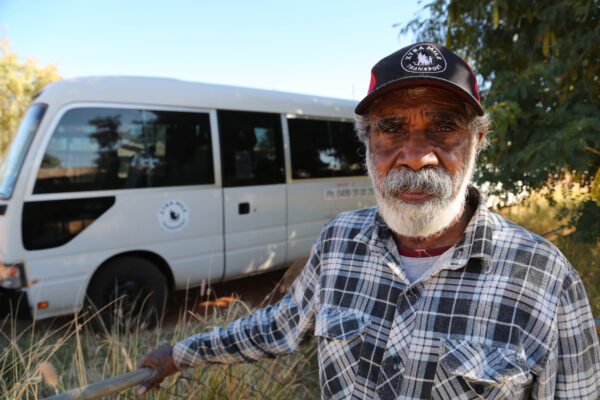
Robert Jampijinpa Robertson’s vision for a Yuendumu-owned and operated transport and vehicle recovery service is one step closer to reality.
Xtra Mile, the social enterprise he started, began running chartered bus services in June.
The milestone followed two years of planning with the Central Land Council’s community development team and volunteers of Community First Development, a com-munity development and research organisation.
“Members were coming and asking if we can take them to Lajamanu, Papunya and all those places, and that’s when I started to think we need to start a bus service or something for our people to get to places they want to go,” Mr Robertson said.
Yuendumu residents have long endured expensive and infrequent transport services, and people traveling to Alice Springs are often stranded for days, missing work and school.
Mr Robertson successfully pitched the social and employment benefits of his bright idea to the community committee of the Granites Mine Affected Area Aboriginal Corporation in May 2019.
Later that year, the committee allocated almost $98,000 to set up a social enterprise and buy two Toyota coaster buses, and almost $27,000 for two remote transport services consultants.
In 2020 it contributed just over $164,000 towards the company’s first year of operations, enabling it to run a charter bus service and establish trust with its customers.
Xtra Mile aims to offer a regular and reliable bus service to the whole community, with return trips between Yuendumu and Alice Springs costing around $160.
Mr Robertson named the company in memory of the travel his family used to undertake by foot.
“In the logo is a little boy being carried by his father,” he said.
“My father used to carry me on his shoulder when I used to get tired, so he had extra load on. He would carry a spear and me on top of all the stuff he was carrying. Extra mile.”
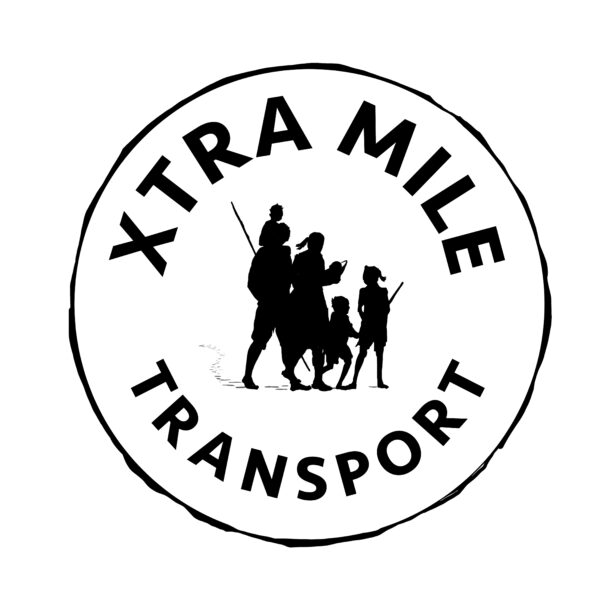
Mr Robertson sourced an additional $250,000 from the Aboriginals Benefit Account, allowing Xtra Mile to employ a social enterprise worker for two years.
Xtra Mile set up shop in an office rented from the Yuendumu Women’s Centre.
The centre also provided secure parking for the buses, and the Wanta Aboriginal Corporation is helping with human resources, governance and financial systems.
Xtra Mile aims to generate enough income to cover a third of its operating costs in its first year.
It is also training and employing locals.
Four Yapa drivers completed commercial passenger vehicle training in Yuendumu, passed their theory exam, medical assessment and got a police certificate.
Two more drivers will undertake the driver knowledge test and a medical assessment in Alice Springs before attending the second Drive Safe NT training in Yuendumu in September.
The company hopes four more drivers will upgrade to a light rigid vehicle license class.
Mr Robertson is proud of what he and the community have achieved so far.
“I think the whole thing is great training and jobs for our mob in the desert, and to strengthen your own business and help people understand what things are possible,” he said.
Background
Papunya is a community 225km west of Alice Springs with a population of approximately 515 people. The CLC’s community development unit conducted consultations and planning sessions with the community between 2013 and 2015 to develop governance arrangements, including a community development working group, and determine what community benefit programs and projects residents would like to allocate their funds to. The community chose a working group to prioritise and plan community benefit projects and in March 2014 it delegated power to the working group to authorise expenditure on completed project plans.
After establishing these governance arrangements, Papunya decided to allocate its initial five year lease money and a small amount of its section 19 lease money income to undertake community benefit projects with the support of the community development unit. From 2012 to 2016 the community allocated $817,450 to 12 community benefit projects which included upgrades to community sporting facilities, improvements to the community store and community transport for health and cultural activities. The community development unit also consulted with residents about compensation income known as the Surprise Well oil affected areas money in 2015 and 2016.
Community members have acknowledged that project governance can be challenging due to competing community interests. The working group initially managed this by funding smaller, less sustainable initiatives, but found it difficult to implement more significant community benefit projects. Between 2016 and 2019 traditional owners decided to distribute most of their lease money to individuals rather than allocate it to projects.
Matched funds trial
At a community meeting in October 2020, however, traditional owners decided to allocate 80 per cent of their community lease income (around $80,000 per year) for the next three years to community benefit projects and to distribute only the remaining 20 per cent to individuals. A significant reason for this reversal was a matched funds trial that sees the income the community allocates to community projects matched dollar-for-dollar by the National Indigenous Australians Agency, thus effectively doubling Papunya’s yearly income for community development projects for three years.
Through this decision, Papunya traditional owners allocated $458,550 section 19 lease money through the CLCs community development program, which was matched with $458,550 matched funds, making a total of $917,101 available for projects. The matched funds program is approved by the Minister for Indigenous Australians from the Aboriginals Benefit Account (ABA).
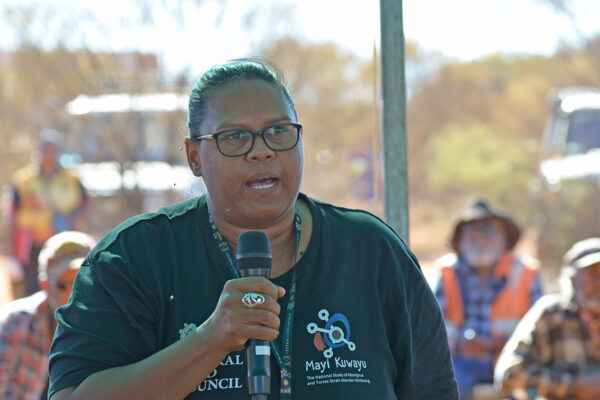
Community members confirmed that the trial was the incentive they needed to allocate the majority of their lease income to community development projects.
“There was a diagram and [CLC staff] explained it. I think it’s good from the government to give us that money…because in our case it’s a lot of money…we looked at it and we actually seen that it was a lot of money because we got it yearly for three years,” working group member and CLC delegate Lynda Lechleitner, (pictured right) said.
The CLC community development team continue to facilitate governance group meetings and consultations with the Papunya community development working group. Community consultations have become increasingly important in the CLC’s work as they allow in depth discussions about projects, governance and associated matters in a less formal setting. They also support the capacity building of individual working group members.
The community increased, diversified and rejuvenated the membership of its working group in 2020 which reflects significant recent changes in Papunya that have seen new younger leaders such as Ms Lechleitner emerge. She described the new dynamic as “the community actually being more open-minded and listening to others”.
“Now there is not just one person speaking. It’s a collective. There are a lot more people thinking ‘that will be a good idea’ or ‘that won’t be a good idea’. You get more discussions,” she said.
Papunya working group member and CLC delegate Terence Abbott said this of the progress that the working group is making; “I just want to see things happen instead of people coming up and down with the same old story. If other people are happy then I’m happy too.”
Working group members now have strong ideas about the future development of their community and want to take full advantage of the opportunity to plan projects with the increased income available through the matched funds trial. Terence Abbott would “like to see a lot of changes with this community”.
“I have been a ranger here since 2010. I was the first one to put my hand up back then. I’d like to see opportunities with tourism [and] fixing up our outstation so we can create employment for our young people,” he said.
At their latest meetings, the governance group continued to move forward with planning and funding their community priorities. In 2021 and 2022, Papunya allocated almost $300,000 of their Matched Funds to two significant community infrastructure projects that community members – through their governance group – identified as a priority: building ablutions at the Papunya sorry camp site and developing shaded community picnic and BBQ areas within the community.
These projects are highly valued as Lynda Lechleitner outlined. “A picnic area for everyone, like even people that are travelling through, so they have actually got somewhere to sit and take a breath before they move on again…projects that are something that the community values”.
The working group has chosen Ranger Works to implement the picnic area project, a fee for service initiative of CLC that prioritises local Aboriginal employment for small scale infrastructure projects.
Ms Lechleitner, from the Town Bore outstation near Papunya, hopes that the community development program will continue to empower her community, “It’s more or less trying to give people a voice and an understanding of what direction they can spend their money in, as a community leader, to better this community. It’s taken a long time for the community to get to where they are now, to tell [the government] what they want as a community.”
“My vision is to get a healthier community where everyone can speak up and be stronger for the community,” she said.
Update February 2023
CLC staff undertook 12 consultations with Papunya’s community development working group members between July and December 2022.
The consultations were part of a process to finalise the picnic area and sorry camp upgrade projects funded by the community’s matched funds and aimed to ensure that residents were involved in the contract and project management.
Working group member Linda Allen said it was important that all working group members can take part in the project development and decision making throughout.
“What is working is [CLC staff member] going around and sitting down and talking to people. It’s a follow-up thing, it’s good. It’s everybody making decisions. When somebody comes up with a good idea [CLC staff members] don’t just go and do it straight away, they are always asking and checking everyone’s opinion,” she said.
The picnic area and sorry camp upgrade projects are due to get underway in 2023, following the execution of contracts with project partners in December 2022.
The Papunya community development working group wants to continue to plan new projects from their priority list.
Update August 2024
Throughout 2023, CLC staff worked closely with governance group members and contracted partners to plan and deliver the ablution facilities at the community sorry camp and community barbeque picnic facilities.
The picnic facilities were completed in August 2023 and the sorry camp ablutions were completed in March 2024.
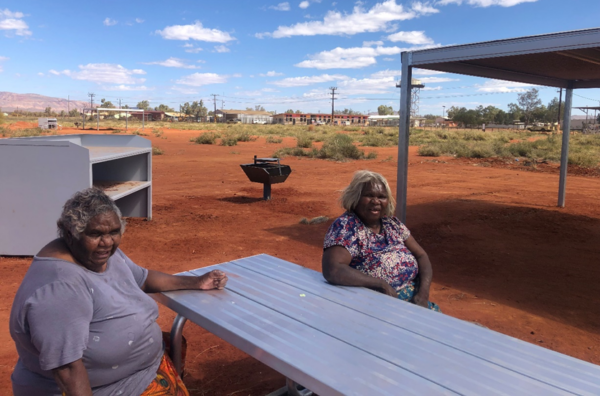
Governance group member Punata Stockman is proud the picnic area project came from a community idea and involved community employment. “I feel happy and proud that it’s happened,” “It’s an Anangu idea, so all Anangu can be happy.” Ms Stockman said.
A younger and very active governance group member, Sarah Stockman explains that despite some frustrations with completion timelines associated with infrastructure projects in remote central Australia Papunya is now able to use these facilities designed, planned and funded by their community. “I’ve lived in Papunya most of my life and I am involved in the working group…It’s just better being in the sorry camp… staying there cause it’s got the toilets and showers…everything that they need there…instead of out into the outskirts of the community where they have to build their own shelters…and the picnic areas are looking really good…they’ve got a barbecue plate, shelters and tables as well where they can actually put their stuff on the tables you know for the cooking and somewhere to sit as well.”
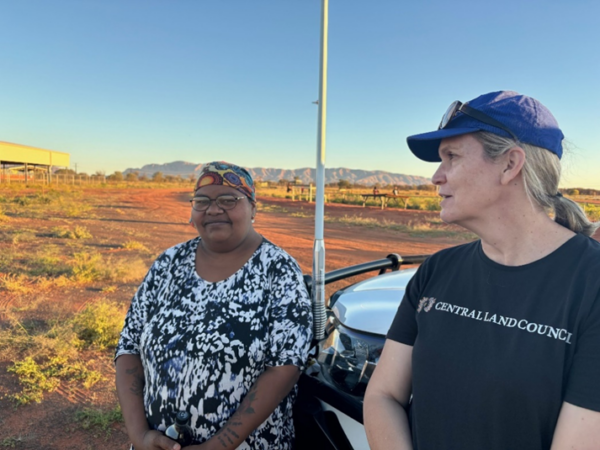
In April 2023, the community also funded a masterplan project. The community will work with remote planning experts to design four playgrounds and an outdoor gym and to investigate community greening and water harvesting options.
The community funded this planning project with the aim of ensuring community can comment on the various aspects of the project and have ownership of the design elements. They also hope it can improve contracting and construction timelines for future community project allocations.
Multiple community consultations on the masterplan project have occurred so far, including trips to Papunya with the CLC and the project partner to consult with community members and stakeholder organisations. A range of community stakeholders are involved in the planning, making it a collaborative process for the aspirations of community members in their development of Papunya.
It is expected that the masterplan will be completed by the end of 2024.
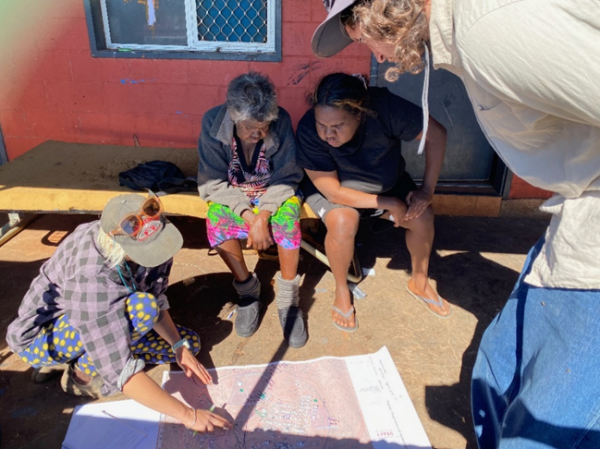
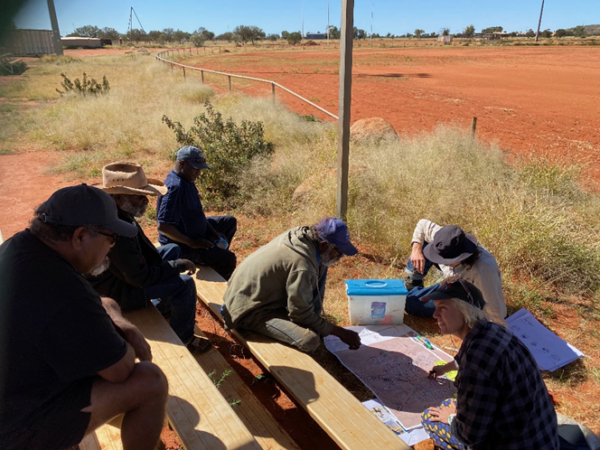
Photos: Landscape architects consult with Papunya community members and community development working group members about the masterplan
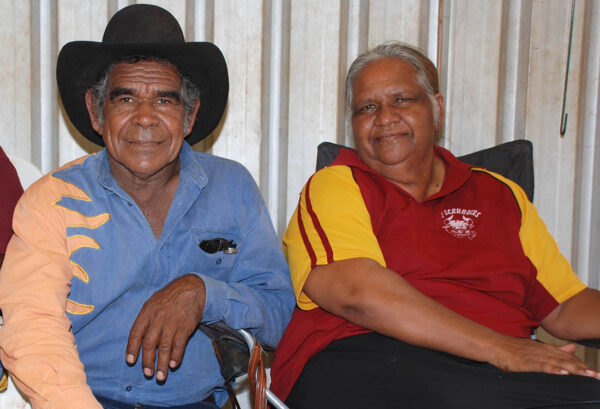
Shirley Dempsey (pictured right) knows the benefits of very remote outstation living. But she also knows the big risks. In recent years, now 64-year-old Ms Dempsey collapsed and had to be flown to Adelaide. Fortunately she was in Alice Springs at the time.
But the timing might have been bad. She might have been at home, nearly 540 kilometres away at her outstation Urlampe, 30 kilometres from the Northern Territory-Queensland border as the as the crow flies, off the unsealed Plenty Highway, and arguably closer to Mount Isa.
So Ms Dempsey and her partner Alan Rankin decided to devote all the $150,000 allocated to their outstation in the Aboriginals Benefit Account outstations project to upgrading their airstrip so it’s Royal Flying Doctor ready.
Other outstations, such as Walka, equally remote in the opposite direction, near the Northern Territory-Western Australia border, south of Kaltukatjara (Docker River), will support their small scale tourism enterprises with the same allocation. Most welcome the funding opportunity to simply make ultra-remoteness more liveable, such as Brumby Plains outstation where resident Desley Rogers is a director of the surrounding successful Mistake Creek Aboriginal-owned cattle station. The station is much closer to Kununurra in Western Australia’s Kimberley region than to Alice Springs.
With about one-third of its $150,000 allocation, Brumby Plains has upgraded its telecommunications to a system allowing mobile telephony and internet access. “With that up and running now, it’s really good,” says Ms Rogers. “I can do a lot of things on my mobile, like check my emails. It’s really good.” Like Urlampe’s airstrip, Ms Rogers also fully appreciates the safety implications of much better communications in such remote circumstances.
The 105 outstations, also known as homelands, in the Central Land Council area each given the chance to receive the $150,000 have the CLC executive to thank for initiating the ABA outstations project. The committee lobbied the Australian Government hard to have $15.75 million provided to outstations in the CLC area from the ABA. The same went to outstations in the Northern Land Council area, and smaller amounts to those in the NT’s two smaller land council areas.
The ABA receives from the government the equivalent amount paid to the government in royalties from mining on Aboriginal land in the NT, for the benefit of NT Aboriginal people. The ABA advisory committee comprised of representatives of the NT’s four land councils makes recommendations to the federal Minister for Indigenous Australians, Ken Wyatt, who ultimately decides on ABA grants. Then it’s usually over to the grantees to do what’s specified in the grant agreement.
The ABA outstations project has involved additional governance and project management complexities, handled in different ways by the different land councils.
The CLC had to find a fair and transparent way to choose the 105 outstations to potentially receive the funding out of the 309 total outstations in the CLC area. If the $15.75 million was shared among all 309 the resulting works wouldn’t have been worth doing. And a fair, clear and comprehensible way of spreading the 105 around the CLC’s nine regions had to be found, considering some regions have many more outstations than others. The project could not initiate new outstations. The project is only for outstation upgrades, with the funding allocated only to those places passing the assessment criteria of need, benefit and capacity.
So, the CLC began the project by surveying as many of the 309 outstations in its area that it could, in regional information sessions with their residents or some-time residents. The survey covered a wide range of data, including existing outstation infrastructure and its condition, supports from service providers and residents’ employment. It has resulted in CLC’s first comprehensive, centralised spreadsheet of outstation data, long overdue, but already due an update to remain relevant and widely applicable to CLC’s various operations.
Summaries of the data, and recommendations based on the assessment criteria, were taken to a council meeting, where the CLC delegates chose the outstations in agreed numbers per sub-region to make up the 105. Fully briefed and integrally involved, they did so without dispute, though over 200 other outstations missed out on the funding entirely.
The CLC subsequently consulted at the chosen 105 towards detailed applications for each addressing the assessment criteria. At last count, the minister had approved 90 of these, with the remaining 15 held up by COVID-19.
Those approved go to the National Indigenous Australians Agency. The NIAA is charged with engaging suitable providers of the works at clusters of the approved outstations, ideally Aboriginal organisations hiring members of the outstations to do some of the work.
With the completion of all works, it is expected more than 100 Central Australian outstations will be better equipped as sanctuaries in the event of crises like COVID-19, indeed safer and more liveable for the Aboriginal residents on their country, crisis or not. Residents like Desley Rogers and Shirley Dempsey of remote Brumby Plains and Urlampe outstations respectively.
Update, 18 November 2022
By design with the CLC at its outset, this project as a whole is now the responsibility of the NIAA, with outstation providers at each of the more than 100 outstations to receive project support.
The CLC has not had responsibility for this project since fulfilling its role by November 2019. Yet it continues to receive inquiries from outstation residents about the project’s progress. It is directing them to call the NIAA on 1800 354 612.
The Wurrpujunta Anyul Mappu digital archive is literally a case of ancient Aboriginal culture meets state of the art digital technology, the Dreaming meets ‘the cloud’.
The archive is an initiative of Julalikari Council Aboriginal Corporation at its impressive Nyinkka Nyunyu Art and Culture Centre in Tennant Creek, 500 kilometres north of Alice Springs. The archive electronically and physically stores cultural and historical material of the many Aboriginal language groups in the Northern Territory’s Barkly region, centred on Tennant Creek.
At peak performance, as a tool of a living, dynamic yet ancient Aboriginal culture at the hands of more local Aboriginal people employed on it, the archive will increase and preserve that material, help transfer the cultural knowledge in it to the groups’ young, and educate the wider public, provided suitable access protocols are in place.
The archive needs Aboriginals Benefit Account funding to reach that potential, largely to modernise its software to a so-called cloud-based platform, better arrange metadata and the electronic archival material itself on this platform, and strengthen archive security while generating more and varied content and wider use. Julalikari is applying to the ABA for the necessary funding with the help of the Central Land Council’s ABA applications support project.
Enterprise and employment, education and training, sport, health and safety, language and culture, land care and land management, building and other infrastructure, media, leadership and youth initiatives are all eligible for ABA funding.
An initiative planned at Arlparra, 250 kilometres northeast of Alice Springs in the Sandover/Utopia region, combines health and safety with sporting infrastructure works, for instance. A horse program at Ltyentye Apurte (Santa Teresa), 85 kilometres southeast of Alice, offers pathways for school students into land and animal management. And the Aboriginal organisations behind these initiatives too have requested the CLC’s ABA applications support project help towards the strongest possible applications to the ABA.
Julalikari director and Nyinkka Nyunyu steering committee member Michael Jones Jampin said that before the digital archive traditional ceremony recordings and those of more public dances were stacked up there in cupboards and drawers. “It wasn’t good that way,” he said. “The archive is the way of keeping everything safe for our next generations.”
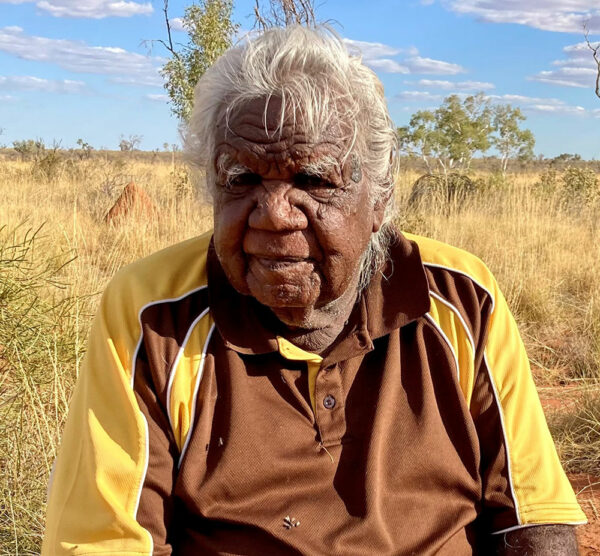
So what did Mr Jones (pictured right) think of the workshop project held with him and others on the steering committee to kick off its help with the archive upgrade application?
“It went good, very well. Helpful,” he said. “A lot of people were saying that was very good.”
The ABA receives from the Australian Government the equivalent amount paid to the government in royalties from mining on Aboriginal land in the NT, for the benefit of NT Aboriginal people. The ABA advisory committee, comprised of representatives of the NT’s four land councils, makes recommendations to the federal Minister for Indigenous Australians who ultimately decides on ABA grants.
The CLC’s ABA applications support project started because the ABA was receiving too many weak or incomplete applications that didn’t meet the minister’s approval, or didn’t even get that far. So, otherwise good Aboriginal initiatives didn’t get funded and the ABA hasn’t benefited as many Aboriginal people as it should have.
The project now gets more requests for assistance than it can handle thoroughly, requiring considerable expectation management with potential applicants and CLC staff alike. The project looks to help those who request it first in each of the CLC’s nine regions, towards a variety of initiatives that require the help and the funding most and that benefit the most people, in Aboriginal organisations who have the ability to manage the funding and make sure their initiative succeeds and lasts if funded. These are the main, but not the only, considerations brought to bear to decide which ABA applications to assist among the many seeking assistance.
Typically the project’s two personnel spend hours with the assisted ABA applicants, workshopping the application assessment criteria of need, benefit and capacity, each initiative’s risk management, the keys to making the initiative last and the documents required to support the application. Then they draft the applications and some supporting documents and stay in touch with the applicants until submission time. Though they give it their best, they don’t do all the work; and they provide no guarantee of funding.
Since starting in earnest in mid-2020 (after six months of COVID-19 restrictions), the project has helped 15 applicants with ABA applications, across eight of the nine CLC sub-regions. Some disengage entirely from the help for their own reasons or because, despite the help, the ABA application process remains a long and difficult one. That is in turn largely because the application guidelines are in dire need of revision.
As part of its ABA applications support project, the CLC has spent considerable time advising the National Indigenous Australians Agency on better guidelines; and in fact has effectively provided two re-drafts.
With clearer, more accessible application guidelines reflecting a more user-friendly and transparent ABA application process, the CLC’s application support may one day no longer be needed. Meanwhile, it is assisting as many applicants as it can towards more sustainable initiatives to benefit Central Australian Aboriginal people. Initiatives like Julalikari’s Wurrpujunta Anyul Mappu digital archive, using hi-tech in the service of ageless Aboriginal traditions.
Update, 18 November 2022
The CLC’s ABA Applications Support Project has received 81 requests for application support from its start in 2020 to November 2022. It has assisted 26 applications across almost all eligible activities and the CLC’s nine regions. Eighteen assisted applications have been submitted to the ABA, worth a total of $38.1 million. Of these, seven have been approved for funding for a total of $4.8 million, three were unsuccessful and eight are still being assessed. Project assistance to one further applicant resulted in funding through the CLC’s $36.7million ‘economic stimulus’ fund, a separate ABA-funded initiative (see https://www.clc.org.au/aba-economic-stimulus-package/).
The project has had to reject most requests for its support due to insufficient resources. Its part-time consultant project manager and single full-time project officer haven’t had time to give more applicants meaningful support. The project would have needed nearly three times the current personnel to fulfil all requests.
This is one lesson from the project. There are others.
Of the three supported unsuccessful applications, two in fact asked for and received minimal project support, suggesting support matters. The seven supported applications approved by the ABA to date received an average of $697,420 in funding each, nearly $100,000 each more than the total cost of the project. They represent a 70 per cent success rate for the project that, if maintained over the remaining eight applications for assessment, would bring an extra $23.3 million in total to the supported applicants combined.
In both current and projected calculations, the project represents very good value for money. It has proved a good investment.
Typically, the project’s support has been comprehensive and prolonged, constituting at least 50 per cent of the substantial work of each application, often more, over many months. It frequently starts with a long workshop with the applicant and builds some applicant capacity on the way towards funding. “We learnt very fast when drafting the application ideas,” a workshop participant surveyed for feedback said.
But the project never did all the work of applications, or else there was no such capacity building opportunity. Because of limited project resources, the capacity building was limited to that around the initiative proposed for funding, not the capacity of the applicant as a whole.
The project too often found this wider capacity patchy or stretched at best.
If eight of the 26 applicants assisted failed to ultimately submit their applications, this is a fair indication that nearly one-third of applicants’ capacity remains too weak to make the most of the project’s support to gain often much needed funds.
There are of course other dynamics at play here, some quite applicant-specific, and wider questions raised about organisational capacity to actually implement initiatives and acquit funding.
The ABA applications guidelines haven’t helped applicants to get funding in the first place.
Revised by the National Indigenous Australians Agency mid-way through the 2021-22 financial year, the guidelines emerged 39 pages long and a poor guide even to applicants with quite strong capacity and the project’s assistance. One said when surveyed: “Without you, I’m not sure we would have been able to get this across the line.” The guidelines may in fact have deterred some applicants entirely.
Hopefully, applicants are given much better guidance to apply to the Northern Territory Aboriginal Investment Corporation, the new body to take over ABA grant application, approval and payment processes.
It is likely some, perhaps many, applicants will still need assistance like that of the CLC’s ABA Applications Support Project. The project manager has suggested modifications to the project, including to help address the issue of some applicants’ incapacity to ultimately apply for funding despite project assistance.
This should further raise the already high value of this CLC project should it be continued, to bring yet more benefit to CLC constituents at comparatively low cost.
Traditional owners of the Yeperenye/Emily and Jessie Gaps Nature Park near Alice Springs will celebrate the official opening of their new public walking and cycling trail between Anthwerrke (Emily Gap) and Atherrke (Jessie Gap) on Wednesday, 28th July.
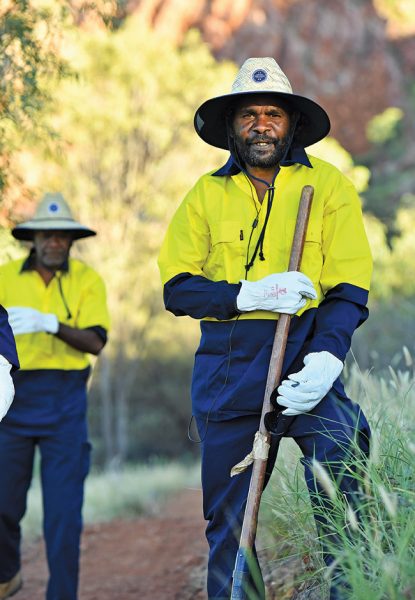
A smoking ceremony and dance at Anthwerrke [UN-door-kwa] at 10.30 am will be followed by an opportunity to experience the trail to Atherke [[ah-TER-ka] with families from the Amoonguna and Santa Teresa communities and lunch.
The $364,000 trail is the biggest investment in public infrastructure by any Aboriginal group in Central Australia.
The traditional owners used the rent income they get for the jointly managed park to pay for the trail because they want to raise awareness of the cultural significance of the area and create employment in trail design, construction and tourism.
More than 30 Aboriginal workers built the 7.2 kilometre trail by hand, receiving one-the-job training by local company Tricky Tracks.
Cultural supervisors were on site during the construction to ensure important sites were respected and protected.
Traditional owners also helped to design the trail which follows the contours of the East MacDonnell Ranges and will feature interpretive signage at the trail heads.
“I’m feeling really proud of this trail launch. We waited six years to do it and now it’s finally here. The families are really excited,” traditional owner Lynette Ellis said.
“Tourists should experience the East MacDonnell Ranges as well as the West Macs,” Grant Wallace, from Amoonguna, said.
Mr Wallace is a member of the traditional owner group that planned and funded the project with the help of the CLC’s community development program.
He was one of the workers who built the trail using hand tools, which minimises erosion.
“It has been good learning new skills and being able to work hard and share this sacred place with everyone,” said Mr Wallace.
“I’m looking forward to using these skills for future trail work around here.”
Wheelchair users can access the dual usage trail at both the Emily Gap and Jessie Gap ends and there is seating at rest stops.
“It’s so the old people and those who aren’t mobile can also come to the site,” Ms Ellis said.
The park is home to significant dreamings, the place where the three caterpillar songlines Yeperenye [Yep-ah-RIN-ya], Ntyarlke [n-CHAYL-ka] and Utnerrengatye [OOT-ner-ung-utch] intersect.
“The trail is an act of generosity by the traditional owners that will not only benefit local tourism, but also create employment on country,” said Central Land Council chief executive Lesley Turner.
“They have so much more to teach us all about their country and visitors are crying out for those experiences.
“We will continue to support traditional owners who wish to invest their collective income in sustainable projects,” he said.
The NT Parks and Wildlife Services will provide the interpretive signage and repair and maintain the trail.
The traditional owners of the Yeperenye Nature Park near Alice Springs have launched a walking and cycling trail between Anthwerrke (Emily Gap) and Atherrke (Jessie Gap) that they financed, built and gifted to the public.
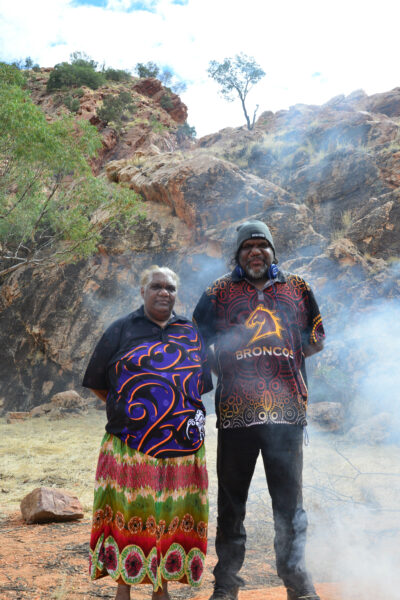
After six years of planning and design and more than six months of construction, around one hundred people gathered at Anthwerrke on July 27 to celebrate the official opening of the trail with a smoking ceremony and a kangaroo tail lunch.
The traditional owners used $365,000 of the rent income they get for the jointly managed national park to fund the trail – the largest sum any Central Australian Aboriginal group has ever invested in public infrastructure.
“It makes me really proud that we did that — putting our money from the government back to the trail here,” traditional owner Lynette Ellis said.
“We did this trail for all of us here, for our young kids now and for our future generations.”
At a time when the industry needs it most, this new public trail will open up another section of the East MacDonald ranges to tourism and local employment.
“Not many tourists come to Jesse Gap, they are always going to the West Macs, so we thought it would be something good to do to attract them out this way,” Ms Ellis said.
“There might be some sort of tour around here with tour guides. We will be doing more projects.”
More than 30 Aboriginal workers built the 7.2 kilometre trail by hand, trained in unique sustainable trial construction by local company Tricky Tracks.
“It has been good learning new skills and being able to work hard and share this sacred place with everyone,” Mr Grant Wallace, a traditional owner and worker on the track said.
“I’m looking forward to using these skills for future trail work around here.”
“This on-the-job, one-on-one training will allow these workers to build and maintain trails across the region,” CLC CEO Lesley Turner said.
Cultural supervisors were on site during the construction to ensure important sites were respected and protected.
The trail which follows the contours of the East MacDonnell Ranges and will feature interpretive signage at the trail heads.
The trail features rest stops and is wheelchair accessible in two sections to ensure visitors of all abilities can benefit from increased access to the East Macs.
Mr Turner told the crowd that the trail shows what can be achieved when traditional owners and local stakeholders work together to realise their ambitions to the benefit of all.
“I want to thank the owners of the Yeperenye Nature Park for their generosity, inclusivity and forward-thinking,” he said.
“You have left a legacy that’s making us all very proud. Of course you were not only thinking of us visitors.
You had your families and young people foremost in your minds and you spread the work around.”
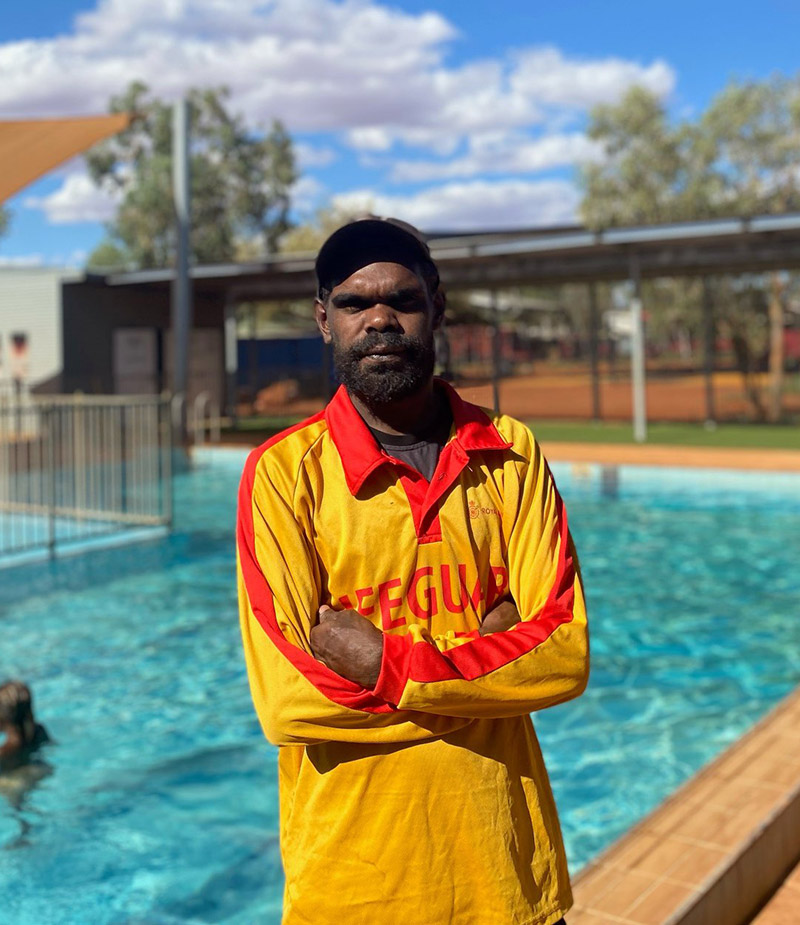
Mutitjulu has its very first home grown life guards to patrol the community’s popular swimming pool.
Five young men undertook lifeguard training in January, and two have qualified as lifeguards.
Clem Taylor and David Cooley completed the course, and Daniel Breaden, Terrence Rice and Christopher Dixon are expected to qualify later in the year.
Mr Taylor and Mr Cooley are now working at the pool as fully qualified lifeguards, alongside the trainees. “I like helping look after the kids and learning about the pool,” Mr Taylor said.
While locals have worked as casual pool attendants and helped to run events, the lifeguards are a first.The lifeguards know how to help someone after a heart attack, provide emergency care and rescue people from the water.
They had to show they could swim at least 200 metres, tow people, and get them out of the water safely. They learnt how to make the whole pool area safe, how to prevent problems and accidents and how to report them. They also worked on their communication skills through role plays and practised how to prevent and deal with problems and conflict.
The training course, like the pool, is funded by the community’s rent income from the Uluru—Kata Tjuta National Park. Using their new qualifications and work experience, the young men can also apply for work at the Yulara pool.
The new lifeguards have brought the community one step closer to its goal of managing the pool all by itself.

Traditional owners of the Yeperenye/Emily and Jessie Gaps Nature Park are using the rent they get for the park to fund a new public walking and cycling trail between Anthwerrke (Emily Gap) and Atherrke (Jessie Gap) in the East MacDonnell Ranges.
The early Christmas present, which will create employment for Aboriginal workers, is the biggest investment by an Aboriginal group in public infrastructure.
“We want to share the place with everyone, and let them know that the community planned and funded it with our rent money,” traditional owner Lynette Ellis said.
The trail will create employment in trail construction, interpretive signage and repair and maintenance, as well as attract tourists to the sacred site 10 kilometres east of Alice Springs.
“Tourists should experience the East MacDonnell Ranges as well as the West Macs,” Ms Ellis said.
Traditional owners will spend more than $330,000 of their NT parks rent to construct the 7.2 kilometre dual usage trail. It will feature wheelchair access sections at both the Emily Gap and Jessie Gap ends, as well as seating at rest points.
“It’s so the old people and those who aren’t mobile can also come to the site,” Ms Ellis said.
The park is home to significant dreamings, the place where the three caterpillar songlines Yeperenye [Yep-ah-RIN-ya], Ntyarlke [N-CHAYL-ka] and Utnerrengatye [OOT-ner-ung-utch] intersect.
“The trail is an act of generosity by the traditional owners that will provide a welcome boost to the tourism industry at a time it needs it most,” Central Land Council chief executive Joe Martin-Jard said.
The CLC engaged Alice Springs company Tricky Tracks to manage the construction. The company plans to hire four workers from the community to build the trail by following the natural contours of the landscape and causing minimal disturbance to the environment.
They will train them in trail alignment and gradient selection, use of hand tools, erosion management and construction techniques.
“I’m looking forward to learning new skills for my future, so I can work in construction,” said Grant Alice from Amoonguna.
Mr Alice is also a member of the traditional owner group that allocated the funds and planned the project with the CLC’s community development program. The NT Department of Environment, Parks and Water Security’s Parks and Wildlife division is partnering with the CLC on the project.
Parks and Wildlife will provide interpretive signage at the trail heads along with trail marking and will repair and maintain the trail, providing ongoing employment opportunities for those acquiring the skills during construction.
This is the third substantial investment the Yeperenye traditional owners have made to enhance the visitor experience at the park.
Two years after installing seats and picnic tables worth $23,000 at Anthwerrke in 2015, the group spent $34,000 of their rent income to develop the Territory’s first interactive visitor app by traditional owners.
The Anthwerrke Experience app walks visitors and tourists through the area’s most significant dreaming sites, ecology and cultural history.
Ms Ellis has many more enterprising ideas for her community to build on the momentum of the trail.
“We would like to run guided tours and have Aboriginal rangers caring for country here too, and an art centre visitors can enjoy at Amoonguna.”
MEDIA CONTACT: Sasha Pavey | 0488 984 885| media@clc.org.au
The federal government must permanently and substantially raise the rate of income support payments and back community-led job creation proposals, a coalition of Aboriginal and human rights organisations says.
The Aboriginal Peak Organisations of the Northern Territory (APO NT), NT Council of Social Services (NTCOSS) and Human Rights Law Centre have joined hundreds of organisations and individuals around Australia in calling for a permanent increase in Jobseeker and other social security payments.
They have signed an open statement supporting today’s National Day of Action organised by the Australian Council of Social Services (ACOSS) at https://raisetherate.org.au/.
NT Aboriginal families, almost half of whom live below the poverty line, have been hit particularly hard by inadequate unemployment support and remote area allowance payments.
Aboriginal people make up just a third of the NT population, but represent 70 per cent of consumers of the NT health system.
They have been trapped in ill health and poverty not only by inadequate support payments, but the discriminatory and punitive work-for-the-dole scheme and compulsory income quarantining.
The government’s community development program has stifled job creation and financially penalised people forced to work for less than a fair wage.
At the same time the cost of food and other essentials in remote communities has been growing, with a basket of healthy food estimated to cost $319 more in a community store than in a Darwin supermarket.
The poorest Territorians are paying close to 60 per cent more for their groceries.
Quotes:
Deborah Di Natale (NTCOSS CEO): “I have seen first-hand the ridiculously high prices in remote communities and the lack of fresh fruit and vegetables on the shelves. This level of inequity should not be tolerated in a country that prides itself on a fair go.”
Joe Martin-Jard (Central Land Council CEO and APO NT representative):“The temporary coronavirus supplement has improved the health of Aboriginal people in remote communities, with stores reporting to CLC staff increased sales of fresh food, essential white goods and warm winter items, as well as a decrease in requests for emergency relief.”
Raising incomes for those who are unable to work or where few jobs exist is absolutely critical but must go hand in hand with a serious commitment to jobs creation in the bush.”
“For those who can and want to work we have a pathway into the world of properly paid employment – we just need the government to act on our remote job creation plan.”
Adrianne Walters (Associate Legal Director, Human Rights Law Centre):“We cannot go back to the indignity of people scraping to survive on $40 a day. The Government should permanently raise payments and end discrimination in the social security system to ensure every person has enough money to live a decent life.”
MEDIA CONTACT: Sasha Pavey | 0488 984 885| media@clc.org.au
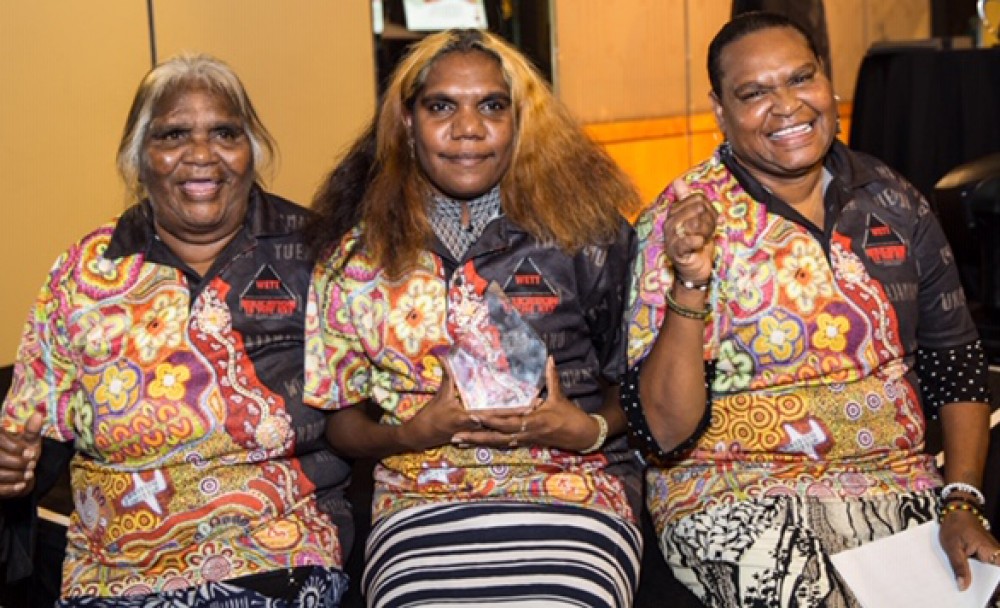
The Central Land Council celebrates its very first Indigenous Governance Award winner – the Warlpiri Education and Training Trust.
The WETT advisory committee last night won the non-incorporated organisations category of the award for its outstanding bilingual and bicultural education and lifelong learning programs in the Northern Territory’s Tanami Desert.
The committee advises the WETT about how to invest gold mining royalties in community driven initiatives supporting the education and training priorities of four remote communities.
Fiona Gibson, a retired teacher from Nyirrpi community and a founding member of the committee, has helped to plan and monitor some of the CLC’s most successful community development programs since 2005.
Ms Gibson accepted the award on behalf of her colleagues.
“We are very proud of what we have achieved working together and of our young people who are now working with us on the WETT advisory committee,” she said.
“They are keeping education strong in our communities.”
Accepting the award with Ms Gibson was Cynthia Wheeler, the new chair of the WETT advisory committee who works at the Yuendumu school.
From a new generation of educators, Ms Wheeler personifies the achievements of the committee’s succession planning.
“Our message for everyone is that education is the key,” Ms Wheeler told the award night crowd in Melbourne.
“Our vision is for Yapa [Warlpiri speakers] to be strong in their knowledge of culture, country and language and to stand up for our communities.
“Our voices will be heard. We will have the same opportunities as everyone else. Our children will be confident, knowledgeable, disciplined, healthy and respected. They will have good roles and jobs, as will the generations to come.”
Both women thanked the traditional owners of Newmont’s Granites gold mine and paid tribute to CLC director David Ross, one of the WETT’s first and most enthusiastic supporters.
The trust kicked off the CLC’s community development program through which dozens of Aboriginal groups in Central Australia have invested a total of around $100 million from their various land use agreements in projects they drive.
One of these groups, from the remote Alekarenge community, was highly commended at tonight’s awards ceremony.
The WETT started when Ms Gibson and her teacher colleagues from Lajamanu, Yuendumu and Willowra asked Mr Ross to help them invest royalty payments in projects to improve education and training outcomes in their communities.
Since then, the trust spent almost $32 million on projects such as community learning centres, school excursions, early childhood and youth leadership programs, bilingual education resources and a Yapa curriculum.

Professor Mick Dodson and his fellow Indigenous Governance Awards judges are visiting Northern Territory communities this week to meet two Aboriginal groups that are investing millions of dollars of royalty and lease income in community development projects.
Award finalists, the Warlpiri Education and Training Trust (WETT) advisory committee and Alekarenge’s community lease money working group, are competing in the non-incorporated governance category with Tangentyere’s Strong Families for Children project in Arlparra.
All three finalists in this category of the national awards are from central Australia, perhaps because the judges value organisations that embed culture at the heart of everything they do.
“We are looking for organisations and initiatives that have the ability to draw upon traditional governance models to effectively respond to contemporary challenges,” Professor Dodson said.
“As judges we recognise that these projects have been at the response of community need, which has enabled consideration of longer term strategies for change.”
Two groups have been recognised for the great work they’re doing in their communities with the support of the Central Land Council’s community development team.
The WETT has supported lifelong learning projects for Yapa for more than a decade.
In 2017-18 alone, the trust invested almost $6.7 million in 14 new community-driven education and training projects in Yuendumu, Lajamanu, Willowra and Nyirrpi.
That’s on top of 21 ongoing projects ranging from community learning centres and early childhood activities to youth diversion and leadership training.
“We have worked for a long time for WETT, all the educators working hard together to make good decisions for the communities and the programs,” Barbara Napanangka Martin, from Yuendumu, said.
Ms Martin is one of the experienced teachers on the WETT committee that monitors the projects and advises the Kurra Aboriginal Corporation on how to invest royalties from the Granites mine in the Tanami.
She plans to tell the judges about the committee’s succession planning and the five new members under the age of 35 who joined the committee following community elections in 2018.
“We are teaching younger committee members who can learn to be strong,” she said.
Since 2012, Alekarenge invested almost $800,000 of its community lease income in youth media, driver training and school holiday initiatives, as well as sports facility upgrades.
A community working group uniting traditional owners and residents from four language groups and all ages committed a further $265,000 for new projects.
Group member Graham Beasley said winning the award would help Alekarenge.
“The prize money would go into our community projects, doing things for our children and their futures.”
The winner will be announced later this year.
See on the Human Rights Law Centre website
Discriminatory remote work scheme improved but onerous work hours and harsh penalties will drive poverty
The need for fair pay for work in Aboriginal and Torres Strait Islander communities has finally been acknowledged by the Federal Government but Budget measures outlined for its remote work for the dole scheme fall well-short of realising this in practice.
The Aboriginal Peak Organisations NT (APO NT) and the Human Rights Law Centre cautiously welcomed some changes to the Community Development Program (CDP), but expressed deep concern about the Government’s piecemeal approach and its decision to continue with onerous obligations while introducing a harsher penalty system in remote communities.
John Paterson, spokesperson for APO NT, said that for three years Aboriginal and Torres Strait Islander organisations have been dealing with the devastation wrought by the Government’s program.
“The hard work of APO NT and other Aboriginal organisations and CDP providers has started to pay-off, with the Minister for Indigenous Affairs recognising that paid work with proper entitlements is the key to lifting families out of poverty, stimulating social enterprise and creating meaningful employment opportunities,” said Mr Paterson.
Mr Paterson welcomed the announcement of 6000 subsidised jobs with proper work entitlements and improvements to the way that people’s work capacity is assessed but said the Government should be adopting the Aboriginal-led model already developed by APO NT.
“We are pleased that there will be subsidies for 6000 jobs and an improved assessment process to ensure vulnerable people are not forced to participate beyond their capabilities.
However, the Government has engaged in a cherry-picking exercise rather than wholeheartedly adopting the positive Aboriginal community-driven model developed by APO NT, which will limit the benefits possible on the ground,” said Mr Paterson.
The Budget measures include a reduction in work requirements from 25 to 20 hours, but people in remote communities, 83 per cent of whom are Aboriginal and Torres Strait Islander, will still have to work around 270 hours more each year than people in urban areas.
Adrianne Walters, senior lawyer at the Human Rights Law Centre, said that it was mindboggling that after three years, a racist and inflexible work hours requirement will continue to be imposed on remote communities, albeit in slightly modified form.
“Equal pay for equal work is a core tenet of Australian society. The Federal Government must eliminate the blatantly discriminatory requirement which sees people in remote Aboriginal and Torres Strait Islander communities forced to work more hours for the same basic Centrelink payment as people in cities,” said Ms Walters.
Both organisations have also warned that the new compliance measures announced in the Budget will undermine the potential for positive outcomes.
“The inclusion of more onerous compliance measures is likely to drive up poverty and disengagement. The Government’s own data indicates that people subject to the remote CDP scheme are already at least 20 times more likely to be financially penalised,” said Mr Paterson.
“Unfair financial penalties have already seen parents struggling to put food on the table for their kids. The Government appears satisfied to dump a new harsh one-size-fits-all penalty system on remote communities, but still discriminate against them in terms of work hours,” said Ms Walters.
Further information
The Aboriginal Peak Organisations NT has worked with other Aboriginal and Torres Strait Islander organisations to develop an alternative model for fair work and strong resilient communities. The model focuses on waged work, fair participation obligations, access to support services and Aboriginal-led institutional arrangements.
Key aspects of the alternative model that are missing from Minister Scullion’s CDPreforms include:
Flexibility and community governance structures so that jobs and community projects meet the needs of communities and remote employers.
An approach to participation obligations that allows local organisations to tailor arrangements to their own communities, with a focus on support and incentives, rather than heavy-handed compliance and financial penalties.
Work activity obligations that are no greater than those that apply to people in the urban Jobactive program.
1500 paid jobs with training for people under 25, giving disengaged young people a reason to re-engage and a pathway to future employment.
An Aboriginal and Torres Strait Islander led agency to manage the scheme instead of the current non-Indigenous led Canberra-based model.
A reduction in pointless and excessive administration requirements, which is a hallmark of the current program and consumes valuable funding.
For interviews or further information please call: Michelle Bennett, Human Rights Law Centre, 0419 100 519
The Aboriginal Peak Organisations NT (APO NT)[1] today welcomed the release of the Senate inquiry report into the Community Development Program (CDP), which found that ‘CDP cannot and should not continue in its current form’[2].
John Paterson, from APO NT said “the inquiry heard the voices of Indigenous CDP participants, their organisations and other concerned Australians and revealed the deep-seated flaws with this top-down, punitive and discriminatory program. Finally, our concerns have been heard.”
“APO NT has put considerable effort into developing an alternative to the CDP (APO NT alternative to CDP). We are extremely pleased that the committee has recognized this Indigenous-led work and drawn on many key elements of the APO NT proposal. In particular, the inquiry found:
The committee is broadly supportive of an effective program for remote jobseekers that provides the opportunity for job placement and community development.
there should be a move away from the compliance and penalty model towards the provision of a basic income with a wage-like structure to incentivise participation.
a jobseeker program must create and sustain real local jobs.
A new program needs to be developed which moves away from a centralised, top-down administration in which communities are told what to do and move towards a model where the local communities are empowered to make decisions that are best for them[3].
It also explicitly recommends that any reform process give consideration to the APO NT model.”
“It is extremely disappointing that the Minister for Indigenous Affairs has already labelled the report misleading and partisan. On the contrary, it provides valuable evidence and recommendations that should inform the CDP reform process,” said Mr Paterson.
The Government committed to consulting with remote communities in May 2017 and just hours before the release of the senate inquiry report the Minister finally released a Discussion Paper outlining very broad reform models for CDP.
“The consultation process announced by the Minister does not answer our calls for a transparent, independent review process conducted in partnership with Indigenous people. The review process is being conducted by the department that currently administers the program, does not appear to include any external oversight or the creation of a high level reform committee to guide and inform the process, and is being undertaken during the wet season and hot summer months when cultural business occurs in many communities,” said Mr Paterson.
“CDP affects the lives of around 29,000 Indigenous people and has caused immense harm. We will continue to work hard to shape the development of a new program to replace CDP that is non-discriminatory, ensures access to the social security safety net, empowers local communities, creates jobs with proper entitlements, and drives development in remote communities. In the meantime, as recommended by the Senate committee, there must be immediate reform of the compliance and penalty regime of the CDP.”
Media contact:
John Paterson (Aboriginal Medical Services Alliance NT), APO NT Spokesperson: 0418 904 727
KEY FACTS ABOUT THE COMMUNITY DEVELOPMENT SCHEME
The CDP is the main program of job related assistance for unemployed people in remote areas of Australia. It is the equivalent of jobactive (formerly JSA) and Disability Employment Services in the rest of the country.
The CDP has around 35,000 participants, around 83% of whom are identified as Indigenous.
People with full time work capacity who are 18-49 years old must Work for the Dole, 25 hours per week, 5 days per week, at least 46 weeks per year (1150 hours per year). Under jobactive Work for the Dole only starts after 12 months, and then for 390-650 hours per year.
Despite having a caseload less than a twentieth the size of jobactive, more penalties are applied to CDP participants than to jobactive participants.
In the 21 months from the start of CDP on 1 July 2015 to the end of March 2017, 299,055 financial penalties were applied to CDP participants. Over the same period, 237,333 financial penalties were applied to jobactive participants.
[1] APO NT is an alliance of five peak Aboriginal bodies, the Northern Land Council (NLC), Central Land Council (CLC), North Australian Aboriginal Justice Agency (NAAJA), Central Australian Aboriginal Justice Agency (CAALAS) and the Aboriginal Medical Services Alliance NT (AMSANT).
[2] Finance and Public Administration References Committee 2017, Appropriateness and effectiveness of the objectives, design, implementation and evaluation of the Community Development program (CDP), p.104
[3] Finance and Public Administration References Committee 2017, Appropriateness and effectiveness of the objectives, design, implementation and evaluation of the Community Development program (CDP), p.104-105
Community development champions from remote Central Australian communities are showing Australia’s international aid sector how they are investing their own money to drive their own priorities.
Graham Beasley, Peter Corbett, Derek Walker and Sabrina Kelly from Alekarenge will tell the annual learning forum of the Australian Council for International Development on Wednesday, 22 November, how they invest their community lease income to address youth issues in their community.
They will follow Fiona Gibson, Sharon Anderson, Hamilton Morris, and Helen Morton from the Warlpiri Education and Training Trust who will share the story of WETT’s first 10 years and what they are planning for the next decade.
All presenters are members of Aboriginal groups driving their own development with their own income and the support of the Central Land Council’s community development program.
Part of ACFID’s ‘community of practice’ for Aboriginal programs, the CLC has helped to organise the sold-out forum from 21-23 November at the Mercure in Alice Springs.
Dr Danielle Campbell, who managed the CLC’s community development team and now heads up the NLC’s new equivalent program, will share the stage with keynote speaker Senator Patrick Dodson and others on Wednesday morning for a panel discussion themed “What is Community Development”?
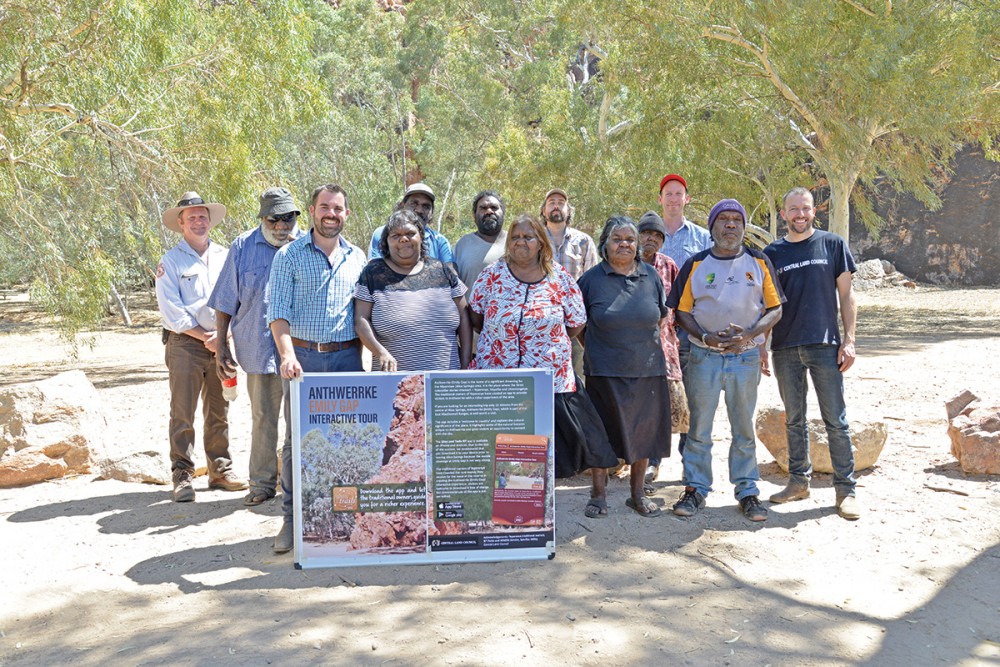
Traditional owners of Anthwerrke (Emily Gap) have invested their rent income from the Yeperenye/Emily and Jessie Gaps Nature Park in an interactive visitor experience at the sacred site near Alice Springs.
They will launch the interactive tour with CLC chair Francis Kelly, the Member for Namatjira Chansey Paech and guests at Anthwerrke on 26 September at 10:30am.
Anthwerrke [UN-door-kwa] is the home of a significant dreaming, the place where the three caterpillar songlines Yeperenye [Yep-ah-RIN-ya], Ntyarlke [N-CHAYL-ka] and Utnerrengatye [OOT-ner-ung-utch] intersect.
The Anthwerrke interactive tour app features the traditional owners welcoming all to country and talking about the significance of the site.
“Without a knowledgeable guide by your side you may be able to appreciate the beauty of Anthwerrke but you would miss out on its stories and leave this special place none the wiser,” said Mr Paech.
“This interactive tour is like having a friend walk through the site with you and explain the hidden meaning of its natural features, its plants, animals and cultural history.
No interpretive sign can pass on this knowledge the way the traditional owners can.”
“It’s a special place for Arrernte people from this area”, said Lynette Ellis, a traditional owner and working group member.
“You’ve got a lot of tourists going to the West Macs but not that many come east.
Those that do come to Emily Gap don’t have much information. Now they’ve got us telling them the stories about this place.”
The app-based experience, a project driven by the traditional owners and supported by the CLC, was four years in the making and cost some $34,000 to develop and maintain.
It is worth every cent, according to Ms Ellis.
“With more people coming to Emily Gap, later there might be more opportunities for cultural experiences with the traditional owners, or they could work on the park as rangers or tour guides,” she said.
The working group’s next project is a walking and bicycle track between Emily and Jessie Gaps.
“Our NT parks rent money community development program is one of the most positive outcomes from the joint management of the 16 parks and reserves in our region,” said CLC director David Ross.
“In 2010 CLC members decided to use 100 per cent of this income stream for community development and last financial year traditional owners invested more than a million dollars of their park rent income in projects they drive.”
Visitors can download the app free of charge from http://sitesandtrails.com.au/ or the app store by searching for Sites and Trails NT. Once downloaded they can search for the Anthwerrke Interactive Experience or navigate there via the Locations list.
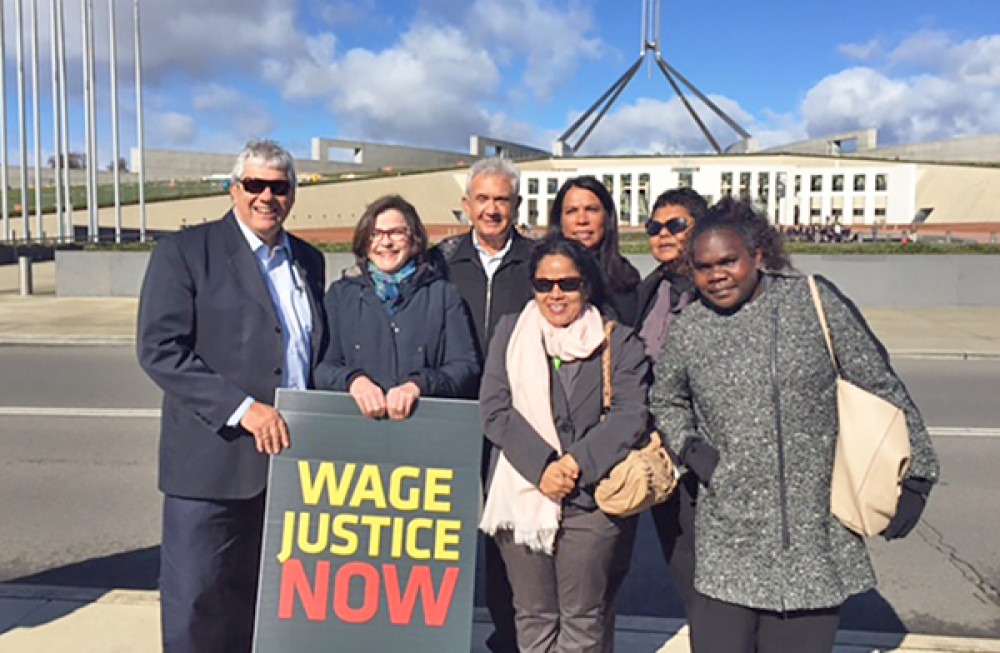
Who: John Paterson, CEO, Aboriginal Medical Services Alliance NT (APO NT), David Ross, Director, Central Land Council (APO NT), Rod Little, Co-Chair, National Congress, David Thompson, CEO, Jobs Australia, Ged Kearney, President, Australian Council of Trade Unions, Maria Harvey, CEO, Tiwi Islands Training & Employment Board, Dickie Bedford, CEO
The Australian Government should replace its racially discriminatory remote ‘work for the dole’ program with an Aboriginal-led model for fair work and strong communities.
In a report to be launched in Canberra, the Aboriginal Peak Organisations NT (APO NT) will call for the Government to afford people in remote communities with respect, opportunity and the same workplace rights that other Australians take for granted.
John Paterson from APO NT, said, “For too long the Australian Government has not listened. Aboriginal and Torres Strait Islander people in remote communities want to take up the reins and drive job creation and community development initiatives. It’s time for the Government to work with us.”
“The current Community Development Program keeps people in the welfare system and excessive penalties are devastating remote communities. Remote communities need a program that sees people employed on decent pay and conditions, to work on projects the community needs,” said Mr Paterson.
The report calls for a new model – the Remote Development and Employment Scheme. The Scheme would create 10,500 part time jobs to be filled by people who are currently receiving below minimum wage social security payments to do work they should be employed to do.
David Ross from APO NT, said, “The new model will see new opportunities for jobs, enterprise and community development and get rid of pointless administration. Critically, the Scheme provides incentives to encourage people into work, training and other activities, rather than punishing people already struggling to comply.”
The Remote Development and Employment Scheme would support young people with paid traineeships. Remote Job Centres would guide people into meaningful jobs, and work with communities to build opportunities for enterprise and long term jobs. People who still require the support of the social security system would have obligations no more onerous than those that apply to people in non-remote areas.
APO NT’s new model has been supported by over 30 organisations, including remote community Aboriginal-controlled service providers.
Further quotes about the report:
Dickie Bedford, CEO, Marra Worra Worra: “Under the CDP communities have lost control, and people feel that it is just the Government telling them what to do. The APO NT model would allow us to employ our own people, with rules that are set to meet our conditions and the aspirations of our communities.”
Maria Harvey, CEO, Tiwi Islands Training and Education Board: “Under CDP, instead of working to get people skilled up to get better jobs, we spend our time on administration so that people can be penalised by Centrelink. A lot of work for the dole projects in remote constitute duties that other people are paid wages for in any other part of the country. The APO NT Model will give a platform for this real job creation to occur. Under the APO NT model our focus would go back to working with the community and individuals to get more people into employment.”
Rod Little, Co-Chair of the National Congress of Australia’s First Peoples: “Congress is encouraged that this model has been developed by people and organisations working on the ground with job seekers.
It aims to ensure success with Aboriginal and Torres Strait Islander people clearly directing the program based on evidence and learning, and focused on achieving long-term results.
We urge the Government to support this program to enhance skills and community capacity building, and eliminate harm caused by unemployment and poverty.”
Ged Kearney, President of the Australian Council of Trade Unions: “The CDP is a racially discriminatory program which is having a devastating impact on jobs in remote communities. Workers in remote communities need jobs which are paid a wage, not unpaid positions in a punitive program which overwhelmingly applies to Indigenous Australians.
The ACTU, through the FNWA, stands with workers in remote communities for the duration of this campaign. We want to see this program scrapped, we want to change the rules for workers in remote communities. We cannot tolerate one rule for people in the cities and another for First Nations workers.”
David Thompson AM, CEO of Jobs Australia: “The Community Development Programme is causing unnecessary financial hardship, exacerbating poverty and doing more harm than good in remote Australia. It has not made significant inroads in providing long-term solutions to joblessness. Indigenous people in CDP are much more likely to get a financial penalty than get a job.”
Adrianne Walters, Director of Legal Advocacy at the Human Rights Law Centre: “The Government’s Community Development Program requires people in remote communities to work up to 500 or 760 hours more over a year than people in non-remote areas without any extra payment. It is a program applied overwhelmingly against Aboriginal and Torres Strait Islander people. This is a racially discriminatory government program that is displacing waged work and must be abandoned.”
Cassandra Goldie, CEO of the Australian Council of Social Service: “The Government must work with Aboriginal people and repair the safety net for remote communities. We have heard story after story of people being penalised, unable to access Centrelink, and ending up without any income support. It is the Government is failing in its duty to ensure that basic social protections are available to those who need them.”
The launch coincides with Senate hearings about the Government’s current Community Development Program, work for the dole program.
A summary of APO NT’s Report can be found here.
Media contact:
John Paterson, APO NT: 0418 486 310
David Ross, APO NT: 0417 899 950
Rod Little, National Congress: 0419 146 871
David Thompson, Jobs Australia: 0419 527 753
Cassandra Goldie: 0419 626 155
Ged Kearney, ACTU: 0400 764 200
Maria Harvey, TITEB: 0439 373 383
Dickie Bedford, Marra Worra Worra: 0458 019 672
Michelle Bennett, HRLC: 0419 100 519
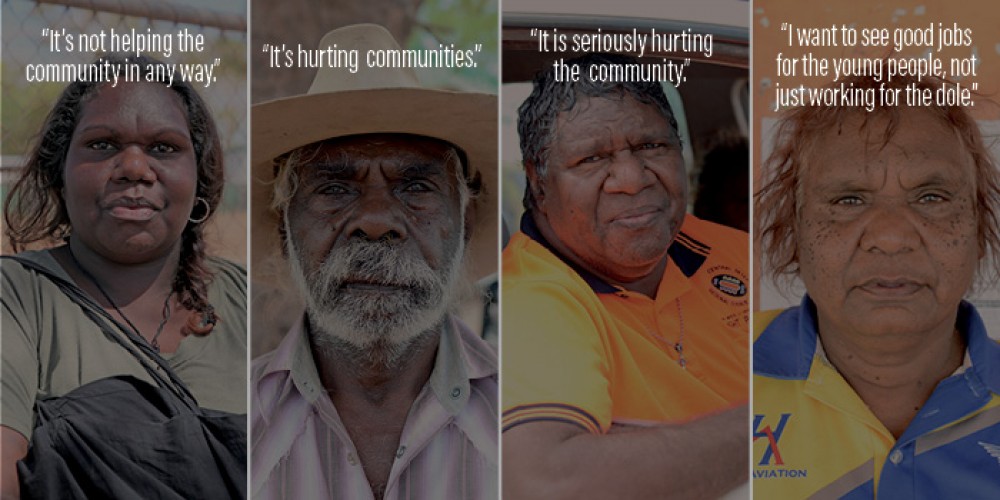
The Northern Territory’s Aboriginal Peak Organisations (APO NT) welcome the referral of a broad ranging inquiry into the controversial Community Development Program (CDP), to the Senate Finance and Public Administration References Committee.
”This inquiry is welcome and absolutely necessary because Aboriginal people in the bush are bearing the brunt of a punitive program that is failing to achieve outcomes,” said APO NT spokesperson David Ross, the Director of the Central Land Council.
“Our remote communities are feeling the combined impact of the program’s onerous work-for-the-dole requirements and the loss of local authority very painfully.”
Independent analysis of government data shows that penalties applied to CDP participants have more than quadrupled since the government introduced the program, and continue to rise.
Despite having only one twentieth of the caseload of the mainstream jobactive system, the CDP now accounts for more penalties than jobactive and punishes some of Australia’s poorest people.
“These penalties mean that a growing number of families can’t put food on the table and pay rent and electricity, and the pressure on those with stable incomes is mounting daily,” Mr Ross said.
He said the social security system fails to protect the most vulnerable because it does not appropriately assess them and does not allow job service providers to use their discretion when dealing with absences, and because participants out bush are finding it even tougher than mainstream job seekers to access the services of the Department of Human Services.
“Improving economic and social opportunity in remote communities is challenging,” he said.
“However the CDP does great harm to our communities while generating little opportunity.”
Mr Ross said the inquiry provides an opportunity to examine the appropriateness and effectiveness of the objectives, design, implementation and evaluation of the CDP in detail, and help generate ideas for reform.
APO NT has written to Minister Scullion seeking a collaborative process for review and improvement of the program.
“We are ready to engage in constructive dialogue with the Minister,” Mr Ross said.
“It is imperative that decisions about ongoing reform and delivery of the program are made in collaboration with Aboriginal communities.
”Ultimately, we are all looking for the same outcomes: increased work participation, new employment opportunities and local control over service design and delivery.”
APO NT wants remote employment service to
establish a program framework giving communities greater control over the design and implementation of employment services in their own location;
provide positive rewards for engagement, rather than punishment; and
focus attention and resources on long-term economic and social development goals.
“Getting the policy settings right is complex and we want to work with the government to achieve positive reform,” Mr Ross said.
“We are particularly pleased that the inquiry does not have to report until September because it is critical that the committee is able to travel to remote communities to hear directly from CDP participants about their experiences.”
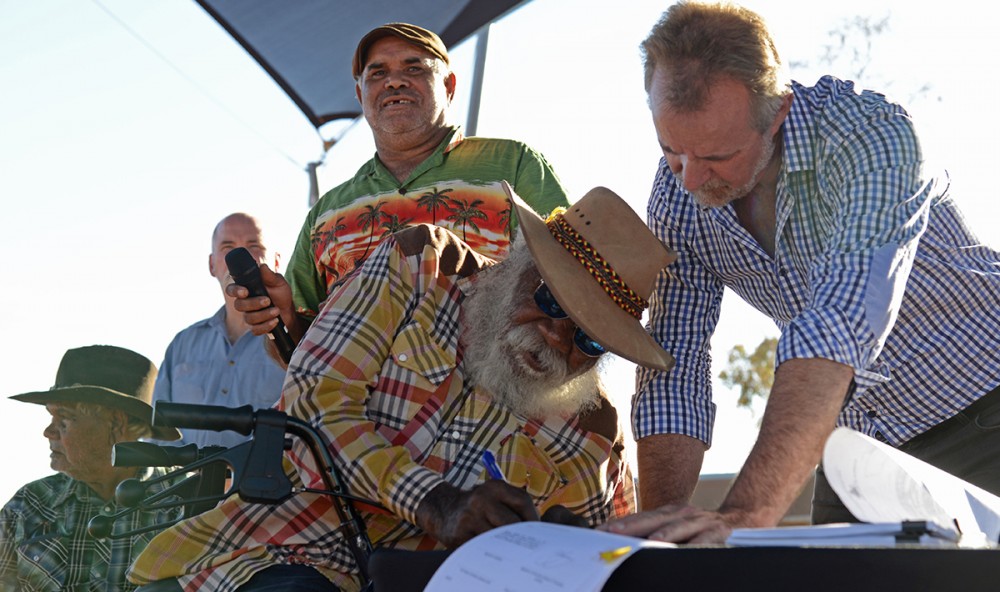
The Mutitjulu community near Uluru today signs off on an innovative township lease that will put traditional owners and residents firmly in control of their future.
“This is a profoundly important settlement between residents and traditional owners – a negotiation about future roles and responsibilities for land use in a community that we hope will be widely emulated,” said Central Land Council director David Ross.
“We have worked with Mutitjulu since 2010 to devise this community-driven leasing model because ceding control over the community to a Commonwealth officer was never going to fly with our constituents,” Mr Ross said.
“Our model keeps decision making in local Aboriginal hands, but also acknowledges the need to build community capacity and strong governance.
It allows for innovation and change in decision making processes under the Aboriginal Land Rights Act.”
Today’s 4pm signing ceremony in the centre of the remote community in the jointly managed Uluru Kata Tjuta National Park follows the ratification of the sublease by the park’s Board of Management.
Last December, traditional owners and the CLC agreed to grant a sublease until 2084, when the head lease of Parks Australia expires.
Initially held by the Commonwealth’s Executive Director Township Leasing (EDTL), the sublease must eventually transfer to a yet-to-be-established community corporation.
This will happen when the CLC is satisfied that the new corporation has the capacity to manage the sublease.
If the corporation runs into trouble, it can be transferred back to the EDTL.
“From today, the EDTL must consult with a committee of residents and traditional owners before making any land use decisions in Mutitjulu,” Mr Ross said.
For the first time, organisations such as the clinic, the school, the store, or a community housing provider will be given legal permission to occupy premises in Mutitjulu and start to pay rent.
“These rent payments will fund community-driven projects similar to the Mutitjulu pool and the many other successful projects pioneered by our community development program,” he said.
There will be no rent payments to individuals and Parks Australia will not charge rent for the sublease.
Mr Ross said when the CLC first proposed its community leasing model, in 2010, the Commonwealth resoundingly rejected it.
“We persevered because traditional owners consistently opposed the Commonwealth’s township leasing model, and we are very pleased Indigenous Affairs Minister Nigel Scullion has accepted our model at long last,” he said.
“We also welcome the additional benefits the Commonwealth has agreed to make available upon signing of the sublease, such as the $10 million investment in community housing, modest accommodation for visiting traditional owners, and $2 million for a community business centre.”
The Mutitjulu Community Aboriginal Corporation (MCAC) requested a sublease six years ago because it wanted to create the certainty the community needs in order to develop with confidence.
Mutitjulu’s location inside a national park leased by the traditional owners to the Commonwealth made the negotiations particularly complex and time consuming.
The Central Land Council has given the green light for an innovative township lease that puts traditional owners and residents of the Mutitjulu community next to Uluru firmly in control of their future.
Traditional owners consented to the sublease last month and the CLC’s 11-member Executive yesterday formally agreed to the grant of a sublease until 2084 over the community in the Uluru Kata Tjuta National Park.
Initially the sublease will be held by the Australian Government’s Executive Director of Township Leasing (EDTL) who must consult with a committee of residents and traditional owners before making any land use decisions in Mutitjulu.
Once traditional owners and residents have built their capacity and established a new corporation the sublease will be transferred.
The EDTL must transfer the sublease to a new community corporation when the CLC is satisfied that the corporation has the capacity to manage the sublease.
This can happen at any time, and the sublease can be transferred back to the EDTL if the corporation runs into trouble.
For the first time, organisations such as the clinic, the school, the store, or a community housing provider will be given legal permission to occupy premises in Mutitjulu and start to pay rent.
These rent payments will fund community driven projects similar to the Mutitjulu pool and many other projects pioneered by the CLC’s successful community development program.
Rent payments will not be distributed to individuals and Parks Australia will not charge rent for the sublease.
“The CLC has worked with Mutitjulu since 2010 to devise this alternative community leasing model because the Australian Government’s model that involved ceding control over the community to the EDTL was never going to fly with our constituents,” CLC director David Ross said.
“Our community driven model keeps decision making in Aboriginal hands and at the local level, but also acknowledges the need to build community capacity and strong governance.
The model allows for innovation and change in decision making processes under the Aboriginal Land Rights Act.
It’s been a profoundly important settlement between residents and traditional owners – a negotiation about future roles and responsibilities for land use in a community. And while Mutitjulu’s situation is unique we hope our model will be widely emulated.”
Mr Ross said when the CLC first proposed a community leasing model, in 2010, the Commonwealth resoundingly rejected it.
“Traditional owners consistently opposed the Commonwealth’s township leasing model, so we persevered. We are very pleased Indigenous Affairs Minister Nigel Scullion has accepted our model,” he said.
“We also welcome the additional benefits the Commonwealth has agreed to make available upon signing of the sublease, such as the $10 million investment in community housing, modest accommodation for visiting traditional owners, and $2 million for a community business centre.
Mutitjulu has been missing out on investment and we hope this is the start of strong new future.
I congratulate the traditional owners and residents for their commitment to working through these complex issues and reaching an agreement on how to move forward.”
The CLC expects the sublease to be signed in 2017, once final arrangements are settled and it has been ratified by the jointly managed national park’s Board of Management.
Within two years of signing, the EDTL and the community consultative committee must agree on a master plan guiding the future development of Mutitjulu.
The CLC, which will remain closely involved in the process, has worked on this proposal for six years, following the request by the Mutitjulu Community Aboriginal Corporation (MCAC) of a sublease.
MCAC made the request in order to bring some certainty to the land tenure so the community could develop with confidence.
The complex and time consuming negotiations affected a lot of parties due to Mutitjulu’s location inside the national park which the traditional owners had leased to the Commonwealth for 99 years when it was handed back to them in 1985.
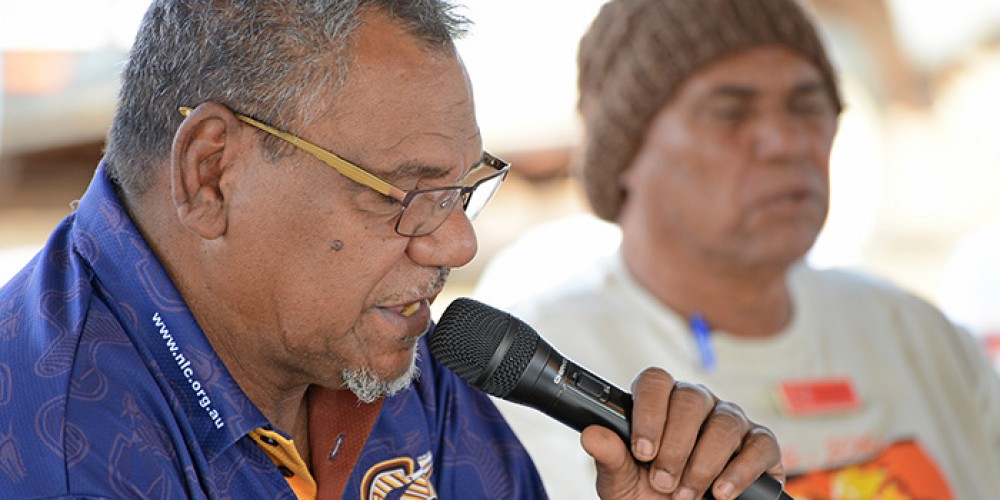
The Northern Territory’s two big land councils have called on whoever wins this week’s NT election to support Aboriginal peoples to drive the development of their lands and waters.
At a historic meeting of the delegates of the Central and Northern land councils at Kalkaringi the delegates passed the following resolution:
“We express our disappointment in the White Paper on Developing Northern Australia and its lack of support for the planning and implementation of Indigenous led developments.
We call on the States, Territory and Commonwealth Governments to work with Indigenous peak organisations to establish a comprehensive planning and implementation strategy focused on delivering economic, ecological and social/cultural benefits to Indigenous people in northern Australia.
Northern Australia holds some of the most important tropical savannah, rainforest and desert landscapes left on earth. Indigenous people are intrinsically entwined in the future of the north and want to play a significant role in its future.
We call on separate resources to be made available to Aboriginal peak organisations to develop the strategy.
Indigenous people are the majority landowners and make up a majority of the population of northern Australia outside of the urban centres.”
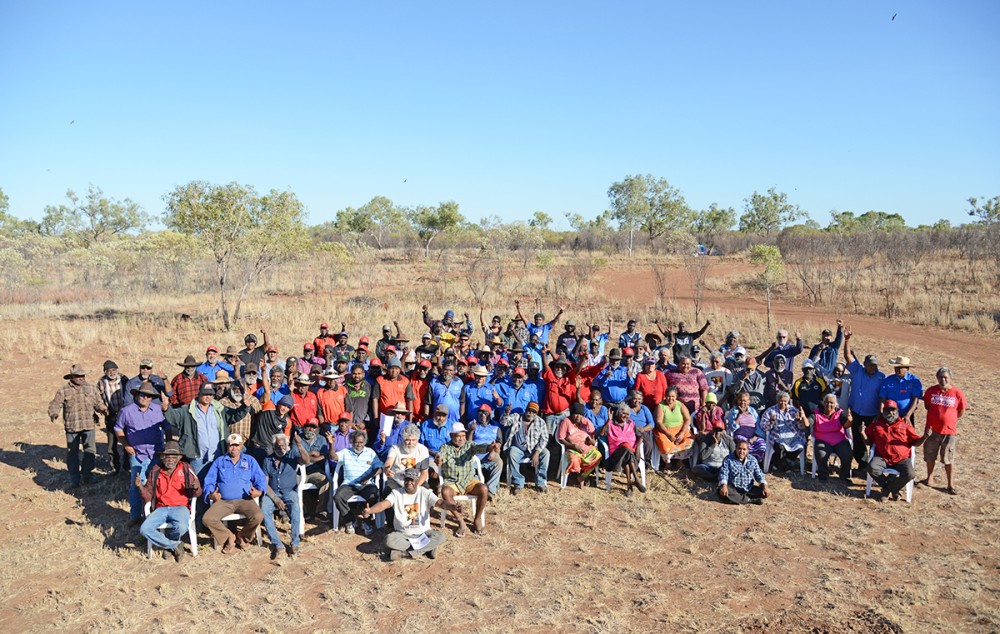
An historic meeting at Kalkaringi of the Northern and Central land councils has demanded that the Federal Government hand control of the Aboriginals Benefit Account to Aboriginal people themselves.
ABA funds are generated by mining on Aboriginal land in the Northern Territory.
The joint meeting of land councils decided to urgently develop a model for self-control.
“The Minister for Indigenous Affairs should have no role in the dispersement of ABA monies,” said CLC chair Francis Kelly and his NLC counterpart, Samuel Bush-Blanasi.
They also rejected changes proposed by the Minister, Senator Nigel Scullion, to reduce Aboriginal representation on the ABA advisory committee.
“Senator Scullion wants to appoint two independent experts to the advisory committee without any consultation,” the chairmen said.
“Our meeting today also called for resources to help remote community organisations apply for ABA funds to drive their own development.”
The land council delegates plan to question the Minister about his proposed changes tomorrow (Thursday).
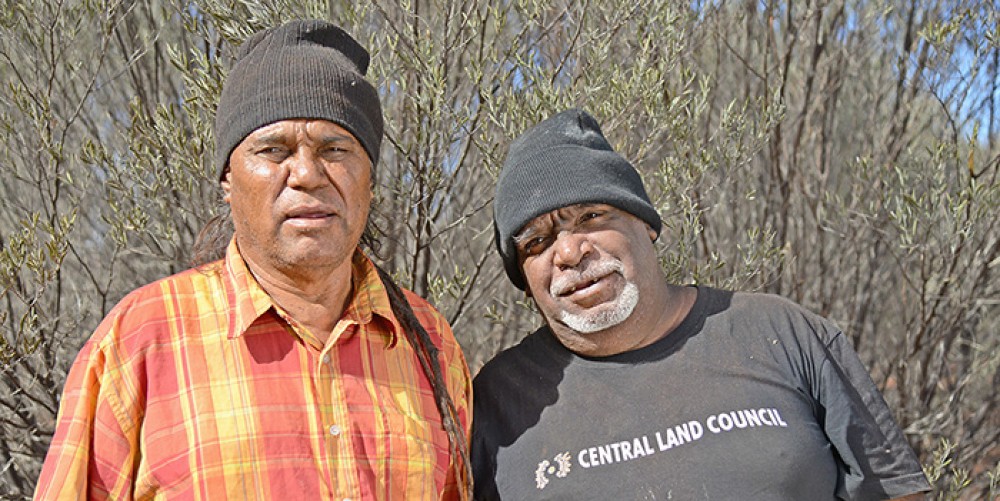
Central Land Council delegates today re-elected Francis Kelly and Sammy Butcher as chair and deputy chair respectively and condemned proposed changes to the ABA Advisory Committee.
Mr Kelly, a film maker from Yuendumu, beat his closest rival for the position of chair, Sid Anderson from Papunya, by 53 to 31 votes.
Papunya musician Sammy Butcher was re-elected deputy chair with 47 votes, while runner-up Michael Liddle received 38 votes at the CLC meeting at Yulara Pulka near Uluru.
“I’m very grateful to the delegates for allowing me to finish the job I began in 2014,” Mr Kelly said.
I’m looking forward to working closely with the CLC executive and the staff, especially Mr David Ross, our director.”
The newly elected nine-member Executive Committee are Ngarla Kunoth-Monks, Norbert Patrick, Teddy Long, Sid Anderson, Michael Liddle, Leo Petrick, Jasper Haines, Sammy Wilson and Owen Torres.
Elected delegates from 75 remote communities and outstations across the south of the Northern Territory also elected members for the Aboriginals Benefit Account (ABA) Advisory Committee.
They elected five members even though the federal Indigenous Affairs Minister plans to cut two of the CLC’s ABA Advisory Committee members from November 2016, and add two hand-picked experts.
The delegates condemned the plan as an erosion of Aboriginal control over the expenditure of the royalties-equivalent-funded ABA community grants program.
“The minister already has the final say and often overrules our advice. It’s time he handed responsibility for Aboriginal money back to the elected representatives of Aboriginal people,” said Mr Kelly, a former ABA Advisory Committee member.
“Aboriginal voters in the Territory will not stand for more top-down control over income they want to use to strengthen their communities. It should be our priorities that count, not the governments’.”
Council, which has reserved two of the five ABA Advisory Committee positions for female delegates, elected Valerie Martin, Barbara Shaw, Phillip Wilyuka, Harry Nelson and Kelvin Morrison.
ABA Advisory Committee members and CLC delegates serve three year terms.
The CLC election was carried out by the Australian Electoral Commission.

